2025 Newsletters
Lily Mason: Interdisciplinary Mobility Efforts

Age-related hearing loss, or presbycusis, is a common chronic condition in older adults, often linked to reduced quality of life. Its effects extend beyond hearing, impacting balance, mobility, safety, and independence. Because hearing and balance share inner ear structures, impairments in either system can increase the risk of falls, further compromising overall well-being. Traditional treatment focuses on hearing aids, which improve communication but do not address broader health concerns, including balance and fall prevention. An integrated approach is crucial for enhancing the overall quality of life for older adults.
Lily Mason conducted a comprehensive functional balance and movement evaluation in both hearing aid users and non-users, emphasizing conscious movement processing as an important psychological factor in maintaining stability and supporting a holistic, integrative approach to patient care. She is a proud contributor to this impactful research as a 2024–2025 Undergraduate Research Fellow, working under the mentorship of Dr. Razan Al Fakir in the Department of Speech, Language, and Hearing Sciences within the College of Liberal Arts.
At the 2025 Auburn University Research Symposium, Lily Mason was awarded first place for her poster presentation. This project is also planned to be presented at the upcoming 37th World Congress of Audiology (WCA 2026), to be held May 24–27, 2026, in Seoul, Korea, and submitted for publication in peer-reviewed journals. She is additionally a contributing author on another publication, titled “Empathy-Driven Through Virtual Reality and Tactile Technologies: A Pilot Study to Promote Empathy in Audiology Education Towards Patient-Centered Care” Published in Medical Science Educator.
In addition to her publication contributions, Lily participated in the International Medical Aid Pre-Physician Associate Internship in Mombasa, Kenya, following her graduation in May 2025. Lily Mason’s accomplishments highlight the exceptional talent and commitment of Auburn University students, serving as an inspiration to her peers and future researchers. She encourages future fellows to invest their time in research, noting that it is both a rewarding experience and an excellent opportunity to solidify career plans for the future.
Toni Lee: Investigating Elements of History

Similar to how some say the eyes are windows to the soul, bones can be considered the windows to one’s health. Bioarcheology is a field that investigates skeletal remains to connect the health quality to past populations and cultures. Identifying elements can provide insight into factors such as insufficient production of red blood cells and nutrient deficiency, which can contribute to anemia. Toni Lee and her professor, Dr. Kristrina Shuler, collaborated to develop the primary research question of the project in Barbados, which aimed to determine the most effective techniques for identifying these characteristics within the bioarcheology community. These efforts were an extension of ongoing work in Dr. Shuler’s lab.
Toni has been very involved in Auburn’s research scene and is rightfully proud of her accomplishments. “I am extremely proud of the results of my research and the work that I put into my research poster and AUJUS highlight. I won the first-place undergraduate research poster (Liberal Arts), and I credit most of that to understanding every aspect of my research because I did all of it myself (from research question, to lab work, to poster, etc.), and I was able to present and answer questions with full confidence. I have worked in labs for most of my time at Auburn, and I presented at the Society for Neuroscience twice and the Auburn symposium once before, so I was accustomed to research and posters, but I had never worked without a partner or mentor assisting closely. My mentor for the fellowship was always available to help, but she let me guide my own research, and I was the one who did every part of it. I am proud to have something completely intellectually my own.”
Toni Lee was a 2024-2025 Undergraduate Research Fellow. Her mentor was Kristrina A. Shuler in the Department of Sociology, Anthropology, and Social Work in the College of Liberal Arts.
Reagan Boledovic: Managing Musculoskeletal Movements

How much physical stress do you think your body could withstand in an occupation that requires you to be clearheaded and well-disciplined for at least eight hours a day? Between the added weight of a duty belt, complex bodily positions, and assumed health of officers, mental and physical morale can be difficult to keep high during a shift. Microbreaks of breathing exercises and stretching are effective ways to encourage mental and bodily health, particularly musculoskeletal health. Partnering with the Auburn Police Department, Reagan Boledovic completed a 16-week study to investigate the outcomes of these microbreaks targeting different muscles around the body.
Through many years in her research lab, Reagan has retained numerous opportunities in addition to her increased skills in discipline, research organization, confidence, and leading discussions. She presented this research at both the 2025 Auburn University Research Symposium and the 2025 National Conference on Undergraduate Research (NCUR) in Pittsburgh, PA. Reagan states, “I am proud of myself for presenting at both the Auburn Research Symposium and NCUR. These both seemed like very scary experiences, but with the help of my research lab and all of the practice I put in, I went to both of these events extremely confident in myself, my work, and my public speaking abilities… My experience at NCUR was particularly valuable to me. Before attending the conference, I was really nervous and anxious going because I was traveling and staying in Pittsburgh by myself. However, this conference brought me a bunch of new friends and introduced me to three people who I got to become close with and who made the experience so much more enjoyable.”
Reagan Boledovic was a 2024-2025 Undergraduate Research Fellow. Her mentor was Dr. JoEllen Sefton in the School of Kinesiology in the College of Education.
Aaron Bohn: Bridging the Gaps

The state of Alabama is known for many things: football, space exploration, and, unfortunately, lower health outcomes. These lower health outcomes contribute to increased health conditions, which can be worsened by varying levels of health and general literacy levels in rural Alabama. Medical resources are typically written at levels that are not easily understood by populations with lower literacy, furthering the gap in healthcare accessibility. Aaron Bohn investigated how this information affects patients at Chambers County Community Health and Wellness Center, located just 45 minutes north of Auburn. Many factors were analyzed throughout the survey, including ease of use, educational resource formatting, understanding of medical terms, and accessibility. The identification of these areas encourages alterations necessary to medical educational resources for an overall improvement in health outcomes in underserved communities.
Aaron’s undergraduate research experience not only revealed the behind-the-scenes preparation necessary for research, but also a new passion for medically related research and health outcomes to enhance his perspective of future practice. With Aaron’s graduation in May 2025 and with many medical school acceptances, he will continue his studies at Mercer University School of Medicine’s Doctor of Medicine Program beginning in the Fall of 2025. Aaron states, “My favorite part of the fellowship was getting to learn how research can impact a community on a concrete level.”
Aaron Bohn started the Undergraduate Fellowship program as a junior majoring in Neuroscience in the College of Liberal Arts. He was a 2024-2025 Undergraduate Research Fellow. His mentor was Dr. Andrea Perkins, Ph.D., in the College of Veterinary Medicine.
Allie Keller: New Perspectives from COVID-19

What social media groups were you a part of during the Covid-19 lock downs? Were you watching Tiger King on Netflix, learning the newest dance for TikTok, or attending “concerts” from your living room couch? What about since then? Allie Keller spent her 2024-2025 fellowship figuring out how social media relates to mental health for students in a post-pandemic world. Specifically, her team looked at student’s experiences with anxiety, depression, and the Fear of Missing Out (FoMO) from 2020 to 2024.
Using data collected from four cohorts of Auburn University students taking psychology courses, Allie and her team found that FoMO and social media usage continue to negatively affect mental health. They also found that anxiety and depression were associated with the COVID-19 pandemic and have been less notable in student populations the farther from the pandemic we get. By understanding these changes, the researchers hope colleges can provide better online support and implement programs to improve the overall wellness of students.
Since wrapping up data collection and analysis, Allie has presented these findings at the Auburn Research Symposium and the Southeastern Psychology Association Poster Presentation. She brought home third place in the Human Sciences, Social Sciences, Creative Arts, and Humanities category at the Auburn Research Symposium. Allie graduated in May 2025 with her Bachelor of Arts in Psychology and has continued her educational journey at Indiana University as a graduate student in their Master of Science in Education: Qualitative & Quantitative Research Methodology program.
Robert Gleason: Progressive Programming

Have you ever sat down to play a game and spent the first 30 minutes establishing how to play the game? In many popular board games, from Monopoly to Sorry, there seems to be a different translation of the rules for every household, which ends up complicating matters. Not to mention, similarly colored playing pieces or hard to follow points systems wreaking havoc on the fun. Luckily for us, there’s a new game in town that has already thought of these issues: Satellite Tycoon.
Over the past two years, Graphic Design student Robert Gleason has been working with Satellites, game players, and Aerospace Engineers (oh my!) to create a game that is not only easy to understand, but easy to play while still being stimulating. Robert focused on three design principles: visual hierarchy, color accessibility, and informational constraints to find the best colors, shapes, and graphics for the game components. By applying user-interface and user-experience concepts to the game, Robert eliminated the need for extensive instruction books and made the game more accessible to those who have visual impairments. Because of Robert’s diligent work, Satellite Tycoon can effectively teach players about the balance between market penetration and space sustainability in a fun and easily understood way. This project was a great example of what happens when worlds (or satellites) collide and how interdisciplinary collaborations can make a world of difference.
Robert was a 2024-2025 Undergraduate Research Fellow and was recently named a “Student to Watch” by Graphic Design USA. He says that his favorite part about the Fellowship was the opportunity to work on an interdisciplinary team and better understand how different fields can benefit from each other.
Since his May graduation, Robert has moved to Illinois but continues to work with Assistant Professor Devon Ward on a speculative design project centered around the concept of Environmental Personhood while job hunting.
Robert Gleason was a student in the Graphic Design department in the College of Architecture, Design, and Construction. His faculty mentor was Dr. Davide Guzzetti, Associate Professor and Ginn Faculty Achievement Fellow in the Department of Aerospace Engineering in the Samuel Ginn College of Engineering.
Learn more about Robert’s undergraduate research project in the highlight article titled “Implementing Design Principles to Improve Scientific Communication and Modeling Via Game Board Development”, by Robert Gleason, Rehman Qureshi, Davide Guzzetti, and Devon Ward.
Serena Tedesco: Impact of Media

Have you ever wondered how social media can impact the world we live in? Well, Serena and her team have collected some interesting data to answer this question. “Due to lack of literature and experience within our country”, Serena says, “we wanted to know if and what we can learn about hunger in the United States from a viral TikTok stitch to guide future researchers on addressing the hunger crisis.”
Serena states that the most rewarding part of her URF experience was investigating a national crisis and being able to talk with fellow researchers to create solutions. This experience allowed her to gain skills in qualitative research, academic research, and thematic analysis. Using these skills, she will be able to apply it to future research studies and job opportunities.
“Personally, this experience has given me confidence that I can learn new skills. The potential impacts of all the research being done by undergraduate fellows are invaluable.”
The team is editing the manuscript from this work to be published shortly. Serena graduated with her Bachelor’s in Global Studies from the College of Human Sciences in May 2024. She is now with Kia Georgia where she works on the corporate relations team. Her mentor was Kate Thornton, who is the Director of Global Education in the College of Human Sciences.
Shelby Morris: Going Green

What are LEED Platinum Certified Hotels, you may ask? Well, they are sustainable hotels that emit less carbon dioxide, use less energy and water, and dispose of waste in a more environmentally friendly way. Her question is: How do they do it, and how are they so successful? This could be key information for the hospitality industry to improve their properties and become more sustainable. For her research, she visited these hotels and interviewed staff members. They found that the initiatives were saving the hotels money, bringing eco tourists, which has a positive impact on internal and external customers.
Shelby states that the URF benefited her greatly. She was able to bring her passion for sustainability and integrate it into the hospitality industry, which gave her the knowledge to be successful in this field. Her goal is to continue to bring sustainability to the tourism industry and create a difference. She stated that her project made her more confident in every facet of her professional self. Along with this, she felt like her writing, industry knowledge, and self-management skills have improved tremendously.
“This program helps give students the fundamental tools and access to opportunities that they would never normally get.”
Shelby graduated with her Bachelor’s in Hospitality from the College of Human Sciences in August 2024. Her mentor was Imran Rahman, who is a professor in the School of Hospitality Management of the College of Human Sciences.
Olivia Grigsby: Walk the Walk

How can watching someone walk be used to measure complex molecules called gangliosides found in our cells? Gangliosides are complex lipids that are found in the membranes of animal cells and play many important roles in the body. Olivia Grigsby and her team sought to find this answer. To them, this is beneficial because developing effective treatments is important to the well-being of those affected by a disease, especially those with terminal diagnoses. Using gait analysis and behavioral tests, they could answer this question using kittens! How cute! Olivia felt like she was able to help guide the directions of future treatments that will be used on less furry patients like humans. The hope is to use her research to extend the lives of children who have a terminal diagnosis.
The URF has helped her show medical schools that she values research. She is committed to research and knows how to apply it to real-world medical problems. She said this process helped her get jobs that will strengthen her resume. During her time as a fellow, she gave an oral presentation at the Auburn Research Symposium, for which she won the Dean’s Award for Academic Excellence.
Olivia Grigsby was a 2023-2024 Undergraduate Research Fellowship and was a Matthew’s Scholar. Her mentor was Emily Graff in the Department of Pathobiology in the College of Veterinary Medicine.
Markelle Scott

Melanoma is an aggressive and deadly type of skin cancer, and 50% of melanomas have a gain-of-function mutation in one of their BRAF genes. Fortunately, these tumors respond relatively well to modern cancer chemotherapies. However, melanomas with unmutated (wild-type) BRAF genes respond relatively poorly to current cancer chemotherapies. Therefore, Markelle and his team are trying to identify the genetic and biochemical changes that cause BRAF wild-type melanomas and develop strategies for treating these tumors. In particular, Markelle is using genetic approaches to test whether increased binding of the ERBB2 protein to the ERBB4 protein causes the proliferation of BRAF wild-type melanomas. If so, anti-ERBB2 and anti-ERBB4 drugs that the FDA has already approved to treat breast, lung, and colorectal cancers may be effective against the BRAF wild-type melanomas.
Markelle stated that the most rewarding thing about his undergraduate experience, besides doing laboratory research, was the opportunity to present his research. “I have never presented before, and this was a great opportunity to work on my composure, communication, and public speaking skills.” This experience allowed him to enhance his deductive reasoning and problem-solving skills. Working with Dr. Riese, he learned how to use genetic approaches to solve a problem and laboratory techniques like gel electrophoresis, plasmid DNA purifications, and mammalian cell culture.
Markelle presented at the National Conference on Undergraduate Research in Pittsburgh, PA. He received a NIH National Cancer Institute diversity grant, is a member of the Melton Scholars program, and serves as an Academic, Engagement, Innovation, and Opportunity ambassador. Lastly, he will participate in an undergraduate research experience at the University of Colorado Cancer Center this summer. Way to go, Markelle, such remarkable achievements! He plans to pursue a PhD in Cellular and Molecular Biology en route to a career as a molecular oncologist.
Markelle is a 2024-2025 Undergraduate Research Fellow and plans to graduate in May 2027 with a B.S. degree in Biomedical Sciences. Dr. David Riese is his mentor; Dr. Riese is a professor in the Department of Drug Discovery and Development in the Harrison College of Pharmacy.
Kaitlyn DiThomas

Have you ever wondered how much your nose knows? While we know that dogs are great sniffers, often seen in airports, at sporting events, and tracking down lost individuals; not much research is available on a human’s ability to pick out scents. Kaitlyn DiThomas set out to find just how much your nose remembers when given familiar and unfamiliar scents to choose from.
Through a series of 72 trials, Kaitlyn tested people’s ability to determine between two scents which one was the new and which one had been used before. This required subjects to use their working memory, which is defined as the memory style that focuses on temporary information processing and is often linked to intelligence when it has been studied using visual and verbal stimuli. But what about when it comes to smells? Through her testing, Kaitlyn discovered that humans have qualitatively similar results to their K9 counterparts but were outperformed when it came to accuracy. Although, the dogs might have had an advantage given their previous training in nose work.
Kaitlyn isn’t ready to give up on our noses just yet. As a junior studying Psychology, she already has plans for a second phase of this study that will provide its human subjects with similar performance training to help them compete with the dogs’ schnoz. She looks forward to broadening her horizons through an Italian study abroad semester and hopes to continue her educational career in the pursuit of a PhD in Clinical Psychology. Outside of the lab, Kaitlyn’s
accomplishments are nothing to sneeze at either. She is a part of Sigma Kappa national sorority, and participates in the BestBuddies club.
Kaitlyn Di Thomas was a member of the 2024-2025 Undergraduate Research Fellowship Program and is on track to graduate December 2025. Kaitlyn says that her time in the fellowship program has allowed her to make better connections to the psychology faculty and gain invaluable research skills. Her Mentor for this project was Jeff Katz, a Professor in the Department of Psychological Sciences.
Amy Hudson

Health disparities have multiple causes, one of which is socioeconomic status (SES). Another contributing factor is the type of job that someone works. Amy and her team examined health disparities across the SES gradient and their relationship with occupational characteristics between 2004 and 2016. They felt this research was important because it can show a relationship between technological changes, the labor market, and health outcomes for certain groups. If these relationships are documented, this can help change industrial policy to improve these groups’ health quality. To obtain her data, she used the US Health and Retirement Study (HRS) and the US Occupation Information Network to look at several cohorts and gather information on BMI, Self-Related Health, etc.
Amy said that the most rewarding aspect of the Undergraduate Research Fellowship was gaining new insight into health disparities that she will carry into her career. She also learned how to plan, prepare, investigate, and interpret data. She used the skillset she developed to aid in Quality Improvement research for residents at a hospital in her hometown. The main goal of this study was to look at patient outcomes and how to improve patient care. The results of this research are published in the January 2025 edition of the American Journal of Surgery in the article, “Analysis of ERAS protocol adherence and postoperative outcomes after major colorectal surgery in a community hospital.” She feels that her experience with her Fellowship has given her the confidence and skills to continue research in her career. “This Fellowship has taught me that I am capable of more than I thought. My self-confidence and mindset regarding research have improved!”
Amy Hudson was a 2023-2024 Undergraduate Research Fellow. Her mentor was Thomas Fuller-Rowell in the Department of Human Development and Family Sciences in the College of Human Sciences.
Mary Ashlee Hughes

A wise movie said, “What are you doing in my swamp?” 🧌
In this case, what are land developers doing to Alabama’s swamps? The muddy mystery found in Coastal Alabama begins with investigating how headwater wetlands are impacted by the surrounding land development. Wetlands usually act like nature’s water filters, but as cities and farms expand, the role of these ecosystems may be shifting. To get a clearer picture, Mary Ashlee Hughes, Dr. Christopher Anderson, and Dr. Thorsten Knappenberger’s wetland lab team used special Indicator of Reduction in Soils films—think of them as “mud mood rings” that reflect chemical balances of the soil—to track soil conditions across eight wetland sites over two seasons. Their findings showed that wetter months led to more hydric (water-saturated) soils, while drier months revealed conditions that were less typical for wetlands, particularly in soils surrounded by urban development. This suggests that human activities might be making it harder for these wetlands to do their job of regulating water flow and quality. This raises big questions about the future of these ecosystems and downstream water quality. With ongoing monitoring and research, the wetland lab hopes to uncover more about these changes and find ways to protect urban wetland systems so they can continue to do their job of improving water quality.
Mary Ashlee’s deep passion for natural resources and conservation shines through her impressive array of commitments. From her hands-on research as a Fellow to her role in Dr. Anderson’s wetland lab, she’s not just studying the environment—she’s actively shaping its future. As a leader in the Society of Natural Resources and a driving force behind multiple initiatives, she’s dedicated to making a lasting impact on the world’s ecosystems. Mary Ashlee’s favorite part of participating in the fellowship was the hands-on field and lab experience and learning how scientific research is structured through guidance from her professional mentors, Dr. Christopher J. Anderson and Dr. Thorsten Knappenberger.
Mary Ashee Hughes started the Undergraduate Fellowship program as a Junior majoring in Natural Resources Management with a minor in Watershed Sciences at the College of Forestry, Wildlife, and Environment. She was a 2023-2024 Undergraduate Research Fellow and graduated in August 2024. Her mentor is Christopher Anderson, Ph.D., in the College of Forestry, Wildlife, and Environment.
Melissa Garnes

Did you know that the Department of Defense (2023) received 8,942 reports of sexual assault from active-duty service members in 2022, and it is likely that there were additional instances as some victims chose not to report their assault? Melissa Games noted that the mental health of our service members is so important, especially those who have experienced traumatic events while in uniform. Melissa Garnes and her team examined the mental health of service members who had experienced sexual assault while on deployment, specifically conditions like depression and anxiety. Findings suggested there was no difference in depressive or anxiety symptoms based on the survivors’ sex or race, yet survivors who did receive mental health support experienced better mental health – fewer symptoms of depression and anxiety – than those who did not seek support.
For Melissa, the most rewarding thing about being an Undergraduate Research Fellow is that she got hands-on experience answering her research questions and making deeper and newer connections with other fellows and mentors. She feels that her time as a fellow allowed her to take a realistic look at the potential future of research. This experience validated her ability to challenge herself academically by learning new things. Some skills she could obtain were formatting research articles and academic posters, getting familiar with SPSS, and interpreting data sets and coding.
Melissa Garnes was a 2023-2024 UR Fellow and presented at the National Conference for Undergraduate Research and the Auburn University Research Symposium. She is currently applying to the master’s program in public health, where she would like to explore her research better and develop her future career. Erin Cooper was Melissa’s graduate mentor, and her faculty mentor was Mallory Lucier-Greer. She is a Human Development and Family Science professor at the College of Human Sciences.
Abigail Law

Dementia is characterized by cognitive deficits and loss of autonomy and is associated with a higher mortality rate. In 2014, there were 7 million adults suffering from this condition, with projections of this population to double by 2026. There is currently no cure for this, but many preventative measures may be possible if we better understand how specific precursors contribute to its development. One causal link that Abby sought to explore was the correlation between a high-salt diet and dementia. During this time, she found that in animal models consuming a high salt diet, inflammation increased in the portion of their brains that is responsible for our working memory. She discovered this by measuring IL6, a protein that helps regulate the immune system and plays a role in inflammation.
Abby has participated in the American Physiology Summit at Long Beach, California, where she was able to see many professors and speakers talk about their research and network with her future colleagues! Being an undergraduate research fellow, she had the opportunity to understand a different part of medicine and learn how intricate the body really is. One of the amazing experiences she has had is having experience with surgical procedures!
Abby Law was a 2023-2024 Undergraduate Research Fellow and graduated with a Bachelor of Science Degree in Biomedical Science. Her mentor was Vinicia Biancardi, who is an associate professor of neurosciences in the College of Veterinary Medicine.
Bailey Branham

We know hearing aids are for hearing speech, but have you ever thought about how they are used to help musicians with hearing loss? Bailey Branham wanted to see if there was a benefit for those who wore hearing aids in singing production and pitch perception abilities. This is important because hearing aids can improve the quality of life of someone with hearing loss. One of the most common activities people enjoy is listening to and producing music. To achieve this goal, they would have to measure each person’s individual ear canal acoustics to ensure that the hearing aids are tailored exactly to their specific hearing loss… NEAT! Bailey then performed a series of auditory tasks involving self-perceived confidence, accuracy, engagement, and expectations with amplification and without.
During her undergraduate fellowship, she stated she gained self-confidence and leadership skills. She was also able to present at the American Academy of Audiology 2024+HearTECH Conference and the 2024 Auburn Research Symposium. By having these experiences, she feels like she developed professionally by learning about ethical research and clarifying the roles and responsibilities of an audiologist. She learned from her experience that research takes time, and patience is key. Bailey stated that she had gained valuable knowledge in the field of audiology, and she confirmed that she would like to pursue her Doctorate in Audiology.
Bailey Branham started the Undergraduate Fellowship program as a Junior majoring in Speech, Language, and Hearing Sciences at the College of Liberal Arts. She is a 2023-2024 Undergraduate Research Fellow. Her mentor is Aurora Weaver, Ph.D., Au.D., CCC-A in the College of Liberal Arts.
Reagan Myers

Organized philanthropy can create innovative solutions and make a real impact, especially given its limited resources compared to large social issues. This gap has led to a focus on finding effective ways to innovate in the past. However, most research on innovation in philanthropy looks outward rather than examining internal practices. Reagan Myers and her team sought to use literary reviews to be able to determine how foundations have been innovated in their funding models. This project aims to look at both practitioner and academic literature and fill the gaps in societal needs left by other sectors. They found that much of the literature focused on funding innovation rather than being innovative. This can be done using grey literature, which is information produced outside of traditional publishing and distribution channels. Using this they can create their own bias about the article.
During Reagan’s time as a fellow, she presented at the NACC Biennial Conference and ARNOVA Annual Conference. Reagan says that through this experience she could better articulate her ideas and have a good understanding of foundation funding. She found that she was comfortable in her ability to locate and organize information as well as talk about her research. She learned tangible skills that allowed her to utilize beyond her research.
Reagan was a 2023-2024 Undergraduate Research Fellow. She graduated in December 2023 with a double major in Human Development and Family Science as well as Philanthropy and Nonprofit Studies. Reagan is currently the Volunteer and Program Coordinator at Our House, a local non-profit organization. Her mentor was Peter Weber who is an associate Professor in the Department of Consumer Science and Design in the College of Human Sciences.
Nicholas Mueller

Did you know that the cotton leafroll dwarf virus (CLDV), the second-most damaging cotton virus, reduces the yield of cotton crops by an average of 12% each year since 2000? Well, Nicholas Mueller wanted to know more about the mechanisms behind the transmission of CLDV with the aim of helping growers manage this virus in their cotton fields. The vector of CLRDV, the cotton melon aphid (Aphis gossyppi), thrives in warm weather and reproduces asexually in the spring through the fall. These aphids transmit CLRDV, an RNA virus, when they feed on infected plant tissue before feeding on a non-infected plant. To learn more about this insect vector, Nicholas wanted to determine the best ways to keep an aphid colony in a greenhouse and to extract RNA from the aphids for use in experiments on CLRDV. He tested two types of aphid colonies, finding that a cage around young cotton plants infested with aphids is an efficient way to keep large numbers of aphids on hand for experiments in a greenhouse while keeping aphids confined to leaves on a mature cotton plant with a mesh bag may be helpful for field trials. Through testing RNA extraction methods on nymphal and adult aphids, Nicholas found that a chemical-only extraction method leads to higher RNA yields, but spin column-assisted extractions result in purer RNA samples. During this project through the Auburn UR fellowship program, Nicholas gained and displayed the ability to start a large and complex project. With this knowledge, he will be a great asset to farmers.
Nicholas graduated in December 2023, majoring in Applied Biotechnology in the College of Agriculture. He was a previous Undergraduate Research Fellow in his senior year. His mentor was Dr. Kathleen Martin, in the Department of Entomology and Plant Pathology. He presented research in May 2024 at the College of Agriculture Plants, Insects, and Microbes Symposium. Nicholas worked for the Department of Entomology and Plant Pathology as a TES Technician and was supervised by USDA-ARS Research Entomologist Dr. Chaoyang Zhao. He currently works at the Donald Danforth Plant Science Center as a Laboratory Technician investigating epigenetics and disease resistance in crops in Dr. Rebecca Bart’s lab.
Emily Kimbrell

How can existing interfaces be made more accessible for all players regardless of educational background? Can this be accomplished by enhancing the communication in regard to players’ actions and their consequences? Emily Kimbrell and her team sought to discover this. They had transitioned Satellite Tycoon from a gamified model to a playable and engaging game by informing players of strategies on resource utilization. Satellite Tycoon (Sat-Tycoon) is a multi-player strategy simulation game where players act as satellite internet providers, which was developed by Dr. Davide Guzzetti, an assistant professor in the Department of Aerospace Engineering, and Dr. Daniel Tauritz, an associate professor in the Department of Computer Science and Software Engineering. Emily and her team were able to gather a focus group to examine the areas where the game could be enhanced through improved feedback. They found that the byproduct of their research was that it helped players enhance strategic decision-making skills. They also improved streamlining the process of building and launching satellites, introduced an intuitive orbital plane visualization to communicate the effects of stochastic events, and integrated a notification system to keep the players aware of the evolving game environment.
Emily stated that the most rewarding part of her undergraduate research experience was looking back on how far she has come. She has gained so much hands-on experience that she has enhanced her technical and soft skills beyond what she has learned in the classroom.
“My research experience has given me great insight into the types of roles I want to take on in the workforce,” said Emily.
Emily graduated in May 2024, and she has accepted a full-time job offer with Integrated Solutions for Systems. She will continue honing her research skills as she creates systems to test vulnerabilities and build solutions using the scientific process. Her research advisor was Dr. Daniel Tauritz who is an associate professor at Auburn University in the Department of Computer Science and Software Engineering.
Abigail Weir

Ever wonder how scientists get so much information about treatments for diseases and how to determine their efficacy? Well, Abigail Weir and her research team focused on looking at single nucleotide polymorphisms (SNPs) in Indian subpopulations that affect the treatment of prostate cancer. You may be asking, what are SNPs? SNPs are parts of DNA that can be mutations or variations that affect our genetic makeup. This is important because if someone has prostate cancer, this can determine how well they can benefit from the treatment. They chose this specific population group because the genetic diversity of India is highly overlooked, which requires a specific study to investigate their pharmacogenetic markers.
Ever wonder how scientists get so much information about treatments for diseases and how to determine their efficacy? Well, Abigail Weir and her research team focused on looking at single nucleotide polymorphisms (SNPs) in Indian subpopulations that affect the treatment of prostate cancer. You may be asking, what are SNPs? SNPs are parts of DNA that can be mutations or variations that affect our genetic makeup. This is important because if someone has prostate cancer, this can determine how well they can benefit from the treatment. They chose this specific population group because the genetic diversity of India is highly overlooked, which requires a specific study to investigate their pharmacogenetic markers.
Abigail states that this research experience was rewarding because she was able to go through the process of creating and managing a research project in pharmacogenomics, the study of how genes affect response to treatments. Through her mentor’s help, she could understand and interpret her data fully. This experience has helped her understand how to work in a molecular pharmacogenomics lab and get an introduction to universally used lab techniques. The URF allowed her to gain confidence in her ability to conduct independent research and intelligently speak about her research. She would like future fellows to know that “having a program which allows students to be in charge of extended research is beneficial to those wanting to understand how to do research for a career and is not training that is gained in class laboratories.”
Abigail is currently a Ph.D. student at the University of Virginia in the Biomedical Sciences Graduate Program. She was a 2023-2024 Undergraduate Research Fellow, and her mentor was Amit Kumar Mitra in the Department of Drug Discovery and Development, Harrison College of Pharmacy.
Click here to learn more about Abigail’s project and her results!
2024 Newsletters
Brianna Gordon

Military members have many healthcare services offered to them to promote their welfare and well-being, but evidence suggests that mental health services are underutilized. Brianna Gordon and her team decided to try and understand two questions: Among soldiers experiencing stress, from which type of providers do they seek help? and Do patterns of help-seeking differ based on whether soldiers consider themselves to be religious or spiritual (R/S) or non-R/S? So, in other words, are soldiers more likely to seek out certain types of providers like medical health professionals, or a Chaplain or Clergy? These questions were important to ask to better understand service utilization among service members and provide a unique lens on their help-seeking behavior. In a sample of over 9,000 soldiers serving in the U.S. Army who reported experiencing at least moderate stress, she found that soldiers who were R/S reported seeking help at similar rates as soldiers who were non-R/S. More specifically, only about 30% of the sample sought help from a provider. Those who identified as R/S tended to seek help from a chaplain or clergy than those who identified as non-R/S.
Bri stated that she feels like this experience helped her prepare for graduate research experiences that she was not able to obtain solely in a classroom. Her aspiration is to be a military psychologist, and exploring research in this field is a major step forward to prepare her for this future profession. This fellowship gave her the confidence to both personally and professionally be able to conduct research and present it. Her mentor was able to provide great guidance, especially while interpreting the results. She stated that the ability to learn about how to change and adapt while conducting research was one of the most valuable experiences in her project.
Brianna was a 2023- 2024 Undergraduate Research Fellow, and her mentor was Dr. Mallory Lucier-Greer in the Department of Human Development and Family Science.
Anna Lancaster

Internal erosion is this sneaky process that can mess up important structures made of earth, like dams, levees, and natural hillsides. Erosion can cause major damage that ends up affecting both nature and the community in big ways. Anna Lancaster’s research dove deep into a specific type of problem known as concentrated leak erosion. Anna and her team were super interested in understanding how it starts, gets worse, and ultimately leads to failure. They studied how the properties of water and mechanics affect the erosion of earthen structures to understand how to make earthen slopes more stable. This laboratory study will enhance our understanding of internal erosion processes in unsaturated slopes. Ultimately, this study focuses on improving our ability to predict and monitor internal erosion. This is important for reducing the chances of issues in critical infrastructure.
In April 2023, Anna received the Kim de Rubertis Scholarship award from the United States Society on Dams for her contributions to this field. After her fellowship, she accepted a graduate research position at Auburn University. She is still studying internal erosion in unsaturated slopes. The most rewarding aspect of her undergraduate experience was seeing how the results from experiments and models advanced the understanding of hydromechanical properties’ effects on unsaturated soil slopes. She explained that her experience with the URF significantly shaped her career by enhancing her technical skills and demonstrating the impact of research on addressing real-world problems. It also prepared her for a future career in geotechnical engineering, where she aims to continue addressing issues related to soil stability. The URF helped her grow in confidence as a researcher through countless hours of lab work and presentations.
“I’m proud of my contributions to the field. I would encourage other students to pursue the URF program, as it provides valuable hands-on experience and opens doors to academic and professional opportunities.”
Anna Lancaster started the Undergraduate Fellowship program as a Junior majoring in Biosystems Engineering at the College of Engineering. She is a 2023-2024 Undergraduate Research Fellow. Her mentor is Jack Montgomery, in the College of Engineering. Anna graduated in May 2024 with a degree in Biosystems Engineering and is currently in the Civil and Environmental Engineering master’s program specializing in Geotechnical Engineering at Auburn University.
Elijah Carroll

Crape Myrtle Bark Scale (CMBS) insects are quite the invaders and can really shake things up for other insects! They provide tasty treats for insect predators and a sugary snack in the form of honeydew. Just to clear things up, we’re not talking about the fruit honeydew here— it’s a sweet, sticky byproduct from insects that consume plant sap, such as aphids and scale insects. Elijah Carroll and his research cohort aimed to determine whether the infestation of CMBS on crape myrtle trees cause seasonal changes in the local insect communities on these trees. Scale insects often hitch a ride into the U.S. through the ornamental plant trade, and once they settle in, they can significantly affect other insect populations. Over an extensive 8-month study, the team found that CMBS presence led to seasonal increases in various insects on crape myrtle trees, including lady beetles, paper wasps, yellow jackets, ants, and houseflies.
During his time as a research fellow, he earned second place at Auburn University’s Undergraduate Research Symposium. He published his findings in the Auburn University Journal of Undergraduate Scholarship, and it is currently under review to be published in Oecologia. Elijah’s most rewarding part of his fellowship experiences was the opportunity to develop his own research questions and design experiments to address them. He stated that this was his first independent research study which allowed him to “grow as a scientist.” This opportunity allowed him to gain invaluable hands-on experience in a field he is passionate about.
He feels like this program solidified his passion for research in invasive insect ecology and built his confidence as a researcher. He would like to let future fellows know that this is a great opportunity for students to explore their scientific interests that shape their academic journey.
“The program creates a space where students can experiment, make mistakes, and ultimately become better problem solvers as a result.” – Elijah Carroll
Elijah Carroll was a 2020 – 2021 Undergraduate Research Fellow finishing his degree in Organismal Biology. He is currently in his first year of his Ph.D. program in the Department of Entomology and Plant Pathology at Auburn University. His mentor was David Held who is the Professor and Chair of the Department of Entomology and Plant Pathology.
Brynleigh Payne

Hello, fellow nature enthusiasts; this week’s edition is on Cuban Brown Anoles (Anolis sagrei). Brynleigh Payne dove into research on these scaly and spectacular creatures to provide insight into how males and females age differently. Through her research, she wants to answer one big question: do telomeres on sex chromosomes (e.g. the X and Y) play a role in defining the shorter lifespan of males relative to females? She believes obtaining this knowledge is important for understanding the aging process and using this emerging model species for vertebrates. She planned two Nanopore sequencing trials to actually sequence through the telomeres on the ends of the chromosomes. What is Nanopore sequencing, you may ask? It is a technique performed in a molecular laboratory for determining DNA or RNA molecule base sequences in single, long reads. Using two variations of Nanopore sequencing trials, they hope to gather data about the genetic make-up of Anolis sagrei that determines their lifespan.
Brynleigh stated the most rewarding thing about her experience was the “preparation time and loading of the flow cell for sequencing.” She says being a research fellow has helped improve her scientific writing and bioinformatic skills. This experience helped her build confidence in conducting and discussing research. She plans to submit her research for publication this year and present it at the Society for Integrative and Comparative Biology’s Conference (SICB).
Brynleigh Payne was a senior majoring in Genetics at the College of Sciences and Mathematics during her Undergraduate Research Fellowship throughout 2023-2024; in which, she was working with her faculty mentor, Dr. Tonia Schwartz. Brynleigh is now a PhD Student in Biology here at Auburn University.
Click here to read Brynleigh’s research highlight article published in the Auburn University Journal of Undergraduate Scholarship.
Collins Keith

Cancer is an aggressive disease, and there is always a need for research understanding how to prevent its spread once diagnosed. Collins Keith, and his colleagues in the Mistriotis Lab at Auburn University, are among the researchers investigating this question. His research revolved around understanding reactive oxygen species (ROS) and how their presence affects cancer cell growth. What are ROS? They are a broad classification of reactive molecules that, in high concentrations, can cause DNA mutation, which might make cancer cells more aggressive. Collins wanted to understand if the small spaces that cancer spreads through in the body change expression of ROS, and whether these changes alter the cancer cells’ behavior. In testing this, he and his colleagues found that ROS increase when cancer cells migrate in small spaces. This increase causes cancer cells to migrate slower, to experience more damage to their nucleus and to have higher rates of death. These results indicate that reducing ROS inside of the body with antioxidants as a cancer therapy for patients may actually help the cancer to grow and proliferate more so than hinder it.
Collins published his research in the AiCHE journal and has been a co-author of two other papers. The first, published in Cell Reports, was another project from the Mistriotis Lab at Auburn, led by Dr. Farshad Amiri. The other is currently awaiting publication with Cell Host & Microbiome, working with Dr. Christopher Bower-Lepts at the University of Cambridge. He is currently at the University of Cincinnati as a first-year medical student, and he is a member of their Medical Scientist Training Program, where he will receive his M.D. and Ph.D. His passion for pediatrics, bioengineering, and developmental biology, will hopefully aid in researching, modeling and looking for treatment of childhood diseases in the future.
Collins states that the most rewarding thing about his undergraduate research experience was spending time in Dr. Mistriotis’ Lab, which gave him a holistic understanding of performing research, allowing him to not only prepare for graduate school but to lead his own individual project. He felt Auburn’s program had a supportive and encouraging environment to help students who want to pursue research. He had his fair share of setbacks, struggles, and mistakes while leading his research project, but it was these setbacks that helped prepare him the most to work through difficult situations in the future. Lastly, on top of all of Collins’s wonderful achievements, he was Phi Kappa Phi’s Most Outstanding Senior at Auburn University in his graduating class! He would like future undergraduate research fellows to know that this program is an invaluable experience with flexibility and the opportunity to take control and develop a project that pertains to their interests.
Click here to read Collins’s research highlight article published in the Auburn University Journal of Undergraduate Scholarship.
Joey Luria

Have you ever heard the saying “money talks”? Well, in our latest newsletter, we’re taking a slightly different angle and talking about financial literacy. Joey Luria wanted to know if marketing approaches can increase financial literacy, education, and awareness. Alabama FAST provides information and resources to students, parents, counselors, career coaches, and administrators to keep them informed on the FAFSA process. The Free Application for Federal Student Aid (FAFSA) is a form that college students complete to their eligibility for student financial aid. This program allows students to take charge of their education and career outlook. To answer his question, Joey utilized Alabama’s FAST program to evaluate participant questionnaires. He then turned to social media to find his answers. Joey found that marketing approaches increased user FAFSA participation and engagement which aligned with Alabama’s FAST program goals.
Have you ever heard the saying “money talks”? Well, in our latest newsletter, we’re taking a slightly different angle and talking about financial literacy. Joey Luria wanted to know if marketing approaches can increase financial literacy, education, and awareness. Alabama FAST provides information and resources to students, parents, counselors, career coaches, and administrators to keep them informed on the FAFSA process. The Free Application for Federal Student Aid (FAFSA) is a form that college students complete to their eligibility for student financial aid. This program allows students to take charge of their education and career outlook. To answer his question, Joey utilized Alabama’s FAST program to evaluate participant questionnaires. He then turned to social media to find his answers. Joey found that marketing approaches increased user FAFSA participation and engagement which aligned with Alabama’s FAST program goals.
Joey found that the most rewarding thing he gained from his Undergraduate Research experience was being able to present his findings at the Auburn Research Symposium. Through this program, he was able to refine his skills in graphic design, organizational communication, and promotions. This experience helped Joey map out his future career path based on his strengths and the challenges he faced during his project. Joey would like everyone to know, “It’s never too early to be proactive, and this program is a great opportunity for students to stand out in their studies.”
But the learning didn’t stop there! Following Joey’s fellowship, he was a graduate intern at Huntsville Blast this summer. He wrote articles, took pictures, and worked on social media. Joey Luria, a Marketing major in the Raymond J. Harbert College of Business, is a 2023-2024 Undergraduate Research Fellow. His mentor is Portia Johnson, who is in the Department of Consumer Design at the College of Human Sciences.
To read his full highlight, click here.
Amelia Flesner

Let’s have a friendly chat about fungi, and yes, I’m talking about the type that affects toes!! Amelia Flesner wanted to understand more about evaluating agricultural and clinical antifungal agents against members of the Fusarium solani species complex (FSSC). Her research aimed to aid the rising need for treatment in the agricultural and medical fields due to their resilience to treatment. To address this problem, she evaluated antifungal agents in clinical and agricultural settings. After observing these treatments, she placed them under a microscope to look at them macroscopically. She found that there was varying effectiveness in inhibiting fungal growth among different treatments in the clinical setting. But, in the agricultural setting, the antifungal Prochoraz prevailed as the most effective plant antifungal treatment.
Amelia stated that the most rewarding thing about her Undergraduate Research Fellowship Experience is that she could perform techniques independently. She also learned troubleshooting methods for her research, which helped expand her knowledge of medical mycology. This experience influenced and validated her to pursue her future career because it grew her passion for mycology. She highly encourages students interested in research to join the Undergraduate Research Fellowship program because it is an extremely rewarding experience that can enhance your undergraduate experience.
Amelia was a 2023- 2024 Undergraduate Research Fellow, and her mentor was Dr. Jeffery Coleman in the Department of Entomology and Plant Pathology. She started the Undergraduate Fellowship Program as a senior and has recently graduated. She has been accepted at Emory School of Medical Technology and Bayfront Health School of Medical Technology for the 2024-2025 school year.
Click here to read Amelia’s research highlight article published in the Auburn University Journal of Undergraduate Scholarship.
Emily Findlay

What do you think about the idea of working remotely for school or in your future career? Emily Findlay wanted to find out, too. She believes it’s super important because her findings can help shape the way we go back to working in offices after the pandemic.
To get her data, she dove into research to understand what people think about working from home. She also administered a survey to see how well people use online tools, how well they communicate, and whether they’re motivated to work remotely. The cool part is that her study found a positive link between feeling confident with online tools and being satisfied, feeling valued, and being motivated while working remotely. This means that if students feel more confident with online tools and communication, they’re likely to enjoy and appreciate remote work more.
For Emily, the best part of her research was coming up with a question and finding the data to support her idea. As a research fellow, she presented her project at the Auburn University Research Symposium and gained a lot more confidence in the research process. This boost will help her as she works towards her master’s degree in I/O Psychology at Auburn University. Emily also wants future research fellows to know that “this program is a fantastic opportunity to develop a wide variety of skills, in addition to building lasting professional relationships with peers and mentors.”
Emily Findlay recently graduated with a Bachelor of Arts in Psychology. She is a 2023-2024 Undergraduate Research Fellow, and her faculty mentor is Dr. Sara Driskell in the Department of Psychological Science.`
Click here to read Emily’s research highlight article published in the Auburn University Journal of Undergraduate Scholarship
Janie Greene

Are you the type of person that experiences “gut feelings?” Are they not always warm and fuzzy? For millions of Americans, those feelings associated with Irritable Bowel Syndrome (IBS) are not fleeting.
Janie Greene conducted a nationwide survey of adults with IBS to assess their approaches to symptom management. Using the nine-term Patient Health Questionnaire (PHQ-9), she found that IBS symptoms were highly correlated with depressive symptoms. Her team also observed that various alternative approaches, such as therapy, probiotics, and dietary changes, had comparable efficacy compared to over-the-counter and prescription medications. Janie stated that the most rewarding part of the undergraduate research fellowship was “exploring the world of the gut microbiome. We have only just started seeing recent improvement in the way gastrointestinal disorders (GI) are managed, and it makes me excited to be a part of it.” In the future, she hopes to pursue alternative options for GI and chronic disease prevention as an educator specializing in gut health. Through her research experience, she learned that some research projects are incredibly meticulous and require much work to achieve the desired outcome.
Janie is currently an Auburn University Rural Health Fellow and serves as a nutrition educator for the Chamber’s County Community Health and Wellness Center. In this role, Janie hosted a cooking class for a local group of women where she talked about the benefits of healthy eating. In partnership with the Health and Wellness Center, she was recently assigned a grant for hypertension prevention. This summer, Janie interned at Auburn Cooperative Extension System, where she created a nutrition curriculum for young adults. In this program, she developed educational modules on holistic ways to care for the body and prevent chronic disease. She also hosted additional food demonstrations and taught her lesson plans. She plans to apply for graduate school to obtain a master’s in nutrition sciences and become a registered dietitian.
To read her full highlight in the AUJUS, click here.
Zachary Miller

Have you ever wondered what can be used to classify and estimate the involuntary tremors in the fingers? Well, that is what Zachary Miller investigated during his Undergraduate Research Fellowship. Zachary used a device that attached an inertial measurement unit to both the proximal and distal interphalangeal joints in the index finger of the left hand. Flexing and extending the finger at a constant rate for 20 seconds provided the data that Zachary needed. Zachary then used the Fast Fourier Transforms (yep, you read correctly!! That FFTs math some students learned in calculus classes Zachary actually used it during day-to-day research!) to identify the tremors from the patient’s voluntary movement.
Zachary said that a rewarding factor about his URF experiences was learning how to implement sensors and write code that allowed him to take the data in real-time. He also gained confidence in conducting research and stated that the Undergraduate Fellowship Program helped him learn skills and methods he will soon need in graduate school.
Zachary Miller is a Mechanical Engineering major in the College of Engineering and a 2022-2023 Undergraduate Research Fellow. His mentor is Chad Rose in the Department of Mechanical Engineering. Zachary recently presented a poster at the 2024 Auburn Research Symposium and Passport to Your Engineering Experience.
This summer, 2024, he started a Master’s degree in Mechanical Engineering and is Dr. Rose’s WeBR Lab Research Assistant. He is now supported by the National Science Foundation, doing further research on using deep neural networks to classify tremors.
To read his full highlight in the AUJUS, click here.
Hope Hartley

People who stutter are reported to exhibit rhythm and timing deficits compared to individuals who do not stutter. For example, previous studies have shown that adults who stutter, as a group, have more difficulty discriminating complex rhythms when compared to individuals who do not stutter, but not for simple rhythm discrimination. These findings support the atypical rhythm risk hypothesis, which posits that differences in neural networks supporting rhythm perception may be one fundamental component of stuttering. Interestingly, ADHD is characterized by deficits in perceptual and motor timing, which is has also been reported in stuttering. Thus, examining rhythm perception may reveal additional similarities between ADHD and stuttering. Individuals 18-50 years of age were recruited for this study using fliers and word of mouth. To participate, participants had to speak/understand English and have typical speech, language, and hearing development (other than stuttering and/or ADHD). The purpose of this study was to determine if adults with ADHD exhibit differences in rhythm perception compared to controls. We hypothesized that no differences in simple rhythm detection would exist between adults with ADHD and the control group. We further hypothesized that adults with ADHD would have more difficulty detecting complex rhythms than controls and that individuals with higher ADHD index scores would have more difficulty with rhythm discrimination than those with lower ADHD index scores.
Hope Hartley started the Undergraduate Fellowship program as a Junior majoring in Speech, Language, and Hearing Sciences in the College of Liberal Arts. She is a 2023-2024 Undergraduate Research Fellow. Her mentor is Gregory J. Spray in the College of Liberal Arts.
Emma Hruska

Alzheimer’s disease (AD) is the most common form of dementia and is marked by abnormal accumulation of beta-amyloid proteins and the hyperphosphorylation of tau proteins that together lead to neuronal degeneration. It is estimated that by 2025, 7.2 million people aged 65 and older will have AD, a 7% increase from the 6.7 million people affected in 2023. Additionally, almost two-thirds of Americans with AD are women, and evidence suggests that menopause is a clear driver for AD development. During this period, hormone levels change due to lack of estrogen, and previous studies have implicated altered hormone levels as a potential factor for AD development. Thus, we hypothesize that increased hormone levels may contribute to the neuropathology and memory loss associated with AD. To test this, we used an innovative adeno-associated virus (AAV)-mediated anti-hormone antibody treatment in APP/PS1 hemizygous mice, a model of AD. We examined changes in estrous cyclicity, hormone levels, memory, and learning behavior. Here, we report that treatment with anti-hormone antibodies significantly disrupts estrous cyclicity, specifically leading to an increased time spent in estrus, and lowers hormone levels 9 months post-treatment. Additionally, treated APP/PS1 hemizygous mice appear to show improvement in a food choice test that measures the social transmission of food preference (STFP), a behavior that deteriorates with neurodegeneration. Overall, AAV-mediated antibody treatments appear to not only disrupt estrous cyclicity likely due to alterations in hormone levels, but also restore learning and memory performance during STFP.
Emma recently presented an oral and poster presentation at the 2024 Auburn Research Symposium this spring. She plans to submit a highlight to the Auburn Undergraduate Research Journal. She plans to apply for medical school after she finishes her undergraduate degree.
Emma Hruska started the Undergraduate Fellowship program as a Sophomore majoring in Genetics in the College of Science and Mathematics. She is a 2023-2024 Undergraduate Research Fellow. Her mentors are Dr. Arthur Zimmerman and Douglas Martin at the Scott-Ritchey Research Center in the College of Veterinary Medicine.
Al Dean Francisco

Aquaponics combines fish farming and crop production in one system which improves sustainability in both fish cultivation and vegetable production. Though aquaponics reduces nitrogen and phosphorus in aquaculture wastewater, waste solids persist. A solution that Dr. Higgin’s lab has offered is to digest the solids followed by algae growth to help eliminate this waste stream. Furthermore, these algae will become fish feed for the aquaponics system, causing the current system to improve its sustainability and contribute to a circular bioeconomy. However, one problem arising from this idea is the potential growth of cyanobacteria, a blue-green algae, which could release cyanotoxins. Fish may ingest these cyanotoxins, which would later become dangerous for those who consume these fish.
Previous work has observed cyanobacteria presence in municipal wastewater. This research addresses these concerns by 1) testing if cyanobacteria are inhibited in strong wastewater like anaerobic digestate with active inoculation; 2) testing a coculture of green algae and cyanobacteria and observing their growth and interactions; 3) testing how much cyanotoxin can be released by cyanobacteria in anaerobic digestate. The results from these tests can be steadily observed and implemented in aquaponics fish waste. Early results suggest that waste nutrients in municipal anaerobic digestate have inhibitory effects on cyanobacteria and further show that green algae can out-compete cyanobacteria in a coculture of strong wastewater. With these results, a new series of tests will focus on varying treatment processes of solid fish waste to find an optimal path for sustainable algal growth for green algae to become fish feed.
Al Dean Francisco started the Undergraduate Fellowship program as a Freshman majoring in Biosystems Engineering in the College of Engineering. He is a 2023-2024 Undergraduate Research Fellow. His mentors are Dr. Brendan Higgins and Post-doc Qichen Wang in the Department of Biosystems Engineering of the Samuel Ginn College of Engineering.
Haomin Huang

Global warming has received widespread attention from the international community. Research indicates that the increase in greenhouse gas concentrations in the atmosphere will have irreversible effects on global warming. Carbon dioxide is the most important greenhouse gas. Forests play a crucial role in maintaining global climate stability through carbon sequestration from the atmosphere when trees grow as well and long-term carbon storage in the wood products which also substitute materials like cement and steel required a lot of fossil fuel to produce. The emerging carbon market would serve as an economic incentive to produce carbon credit which has price on the market allowing entities that emit greenhouse gas to purchase carbon credits from those who have successfully reduced or sequestered carbon with lower opportunity costs than the price. Forest management and wood use are competitive in terms of the costs. The market would generate social welfare for both forest practice and management and the carbon credit buyers. This project aims to investigate the existing dynamics within the forest carbon market, focusing on key aspects like the analysis of supply and demand as well as the overall market structure. Moreover, I examined various approaches for fostering growth in the forest carbon market. This involved looking into the establishment of a dedicated trading platform for forest carbon and understanding the external influences impacting this market. Through this comprehensive analysis, the research seeks to shed light on both the current state and the potential pathways for advancing the forest carbon market.
Haomin Huang started the Undergraduate Fellowship program as a Junior majoring in Finance in the College of Business. He is a 2023-2024 Undergraduate Research Fellow. His mentor is Yaoqi Zhang in the College of Forestry, Wildlife and Environment.
Adeline Flach

Pollinators are essential in natural and managed ecosystems. However, the loss of floral resources, primarily due to land use changes, has contributed to widespread pollinator decline. The positive effects of biochar, a carbon-based soil amendment, on the growth of agricultural crops suggest it may benefit the growth and health of pollinator-friendly wildflowers. However, this has been sparingly tested in field settings. Thus, the goal of this study was to investigate if there was a difference in the Normalized Difference Vegetation Index (NDVI) – a proxy for plant health – between biochar-amended and unamended plots. To distinguish plot variability, a DJI Mavic 3 Multispectral unoccupied aerial system (UAS), flown at 12 m altitude, was used to collect very high-resolution aerial and multispectral imagery (0.55 cm/pixel) at three sites across Auburn, AL. Data were collected five times at each site between May to October 2023. Each site was ~10,000 ft2 in size and subdivided into eight subplots: four experimental (containing biochar) and four control (not containing biochar). UAS imagery was processed using Pix4Dmapper and resulting raster bands were used to generate NDVI values for each subplot in ArcGIS Pro. Additionally, the Zonal Statistics as Table tool was used to calculate the mean, min, max, and standard deviation of NDVI values by subplot. Those variables were then compared between experimental and control subplots using general linear mixed effect models from the package ‘lme4’ in the R statistical computing environment. The results showed that there was no statistically significant difference between control and experimental plots [mean NDVI score difference of 0.009 (±0.021 C.I., p=0.37)], indicating no effect of biochar on NDVI values within the experimental time period. Future work will investigate potential time-lag effects.
Adeline presented her poster at the 2024 Auburn Research Symposium this Spring. She plans to submit an highlight article to the Auburn Undergraduate Research Journal and possibly an expanded version of the study to the Frontiers in Plant Science journal over the summer of 2024.
Adeline Flach started the Undergraduate Fellowship program as a Junior majoring in Environmental Science in the College of Agriculture. She is a 2023-2024 Undergraduate Research Fellow. Her mentor is Stephanie Rogers in the Department of Geosciences
Mae Howell
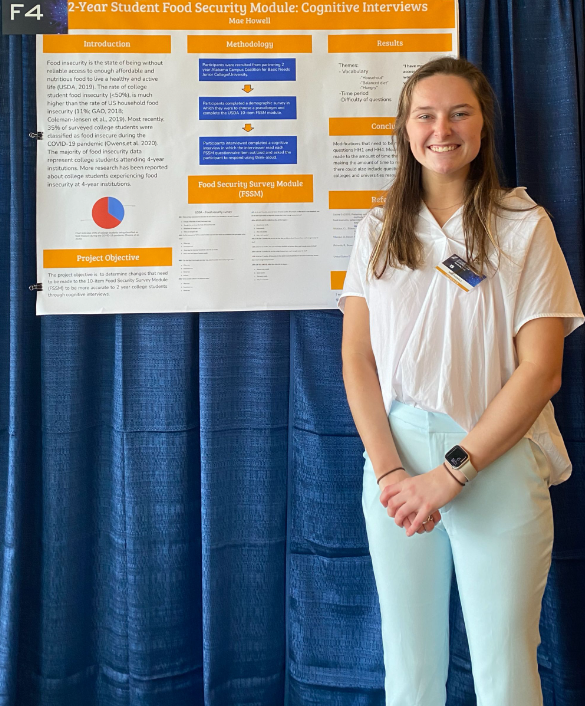
Food insecurity is the state of being without reliable access to enough affordable and nutritious food to live a healthy and active life. The rate of college student food insecurity (<50%), is much higher than the rate of US household food insecurity. Most recently, 35% of surveyed college students were classified as food insecure during the COVID-19 pandemic. The majority of food insecurity data represent college students attending 4-year institutions. More research has been reported about college students experiencing food insecurity at 4-year institutions. Thus, the importance of determining and addressing food insecurity at 2-year institutions will add to the body of literature and impact health and societal outcomes. Mae Howell’s project objective is to determine changes that need to be made to the 10-item Food Security Survey Module (FSSM) to be more accurate to college students through cognitive interviews.
Based on responses from the 10-item FSSM, students were determined to be food secure or food insecure. During the recorded semi-structured, virtual interview, participants responded to questions about the 10-item FSSM. The interviews were analyzed by theme using qualitative analysis software (ATLAS.ti) to determine needed modifications relevant to 2-year college students. These data will be used to inform modification of wording and verbiage of the current USDA 10-item FSSM to create a FSSM to use for 2-year college students.
Mae Howell, a Junior majoring in Nutrition Dietetics in the College of Human Sciences is a 2022-2023 Undergraduate Research Fellow. Her mentor is Onikia Brown, in the Department of Nutritional Sciences.
To read her full highlight in AUJUS, click here.
Cyrus Lloyd
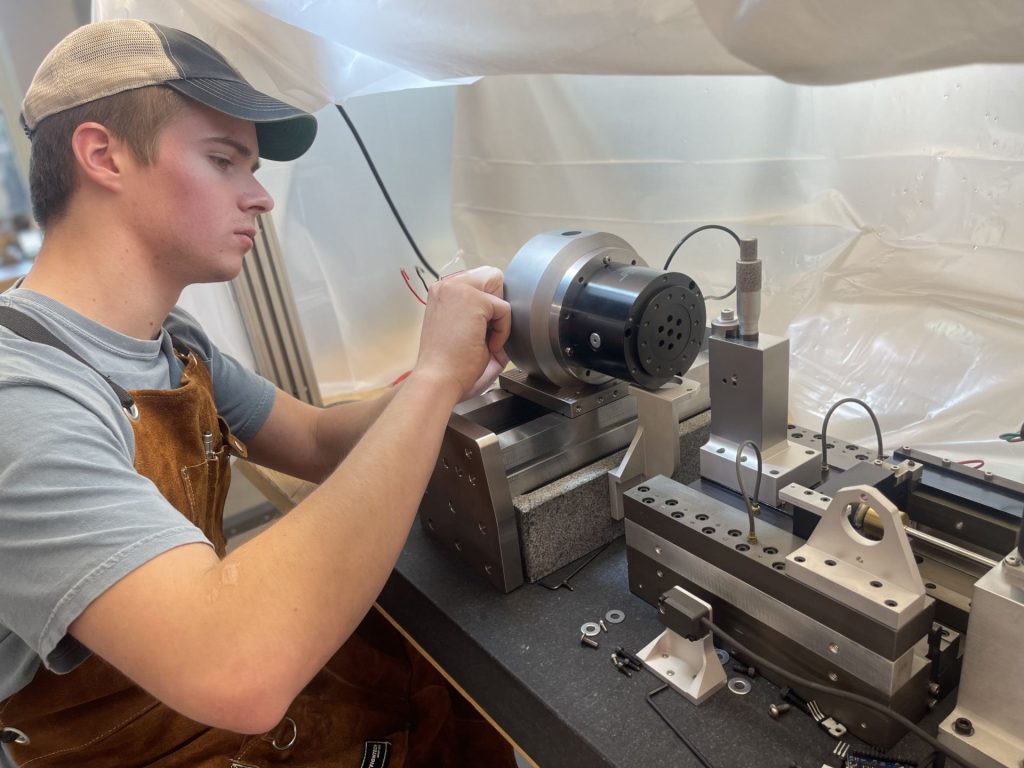
The state of the art in the field of ultraprecision manufacturing is represented by diamond turning lathes. These machines are capable of producing parts accurate to well under 1 micrometer with surface finishes in the single digit nanometer Ra range. They are the precision behind everything from mass-produced optics to cutting-edge scientific research, yet limitations in their cost and work-holding methods limit productivity. Common slow manual part mounting and alignment methods make high production difficult on such machines. A low cost diamond turning lathe that includes a novel work-holding solution was developed to address these areas and bring this capability to the university. Using principles of precision engineering and machine design, a diamond turning lathe capable of sub-micron accuracy and sub-10 nanometer Ra surface finish was designed and built. The X and Z axes consist of custom hydrostatic and aerostatic box ways driven by linear motors and a non-influencing friction drive bar system. Using these engineered machine elements in conjunction with high precision position feedback sensors; the axes maintained a positional stability and resolution of less than 25 nanometers and a positional accuracy of less than 100 nanometers over the travel of the machine. Concurrently, a kinematic pallet work-holding system was also developed to eliminate the inefficiencies of manual part mounting workflows. This was shown to be repeatable between mountings to within 0.5 micrometers, reducing setup time by 1000% in certain applications. Several test parts were machined from aluminum and copper using a monocrystalline diamond cutting tool. Part quality was inspected via Fizeau interferometry and atomic force microscopy to validate form and finish, respectively. The finished machine expands the university’s manufacturing capability with an increase in precision on the order of 10x. This software will also include error compensation features to remove almost all remaining geometric errors, and incorporate a thermal error model.
Cyrus Lloyd, a Senior majoring in Aerospace Engineering in the College of Engineering is a 2022-2023 Undergraduate Research Fellow. His mentor is Jordan Roberts, in the Department of Mechanical Engineering.
To read his full highlight in AUJUS, click here.
McKae Sarkowski
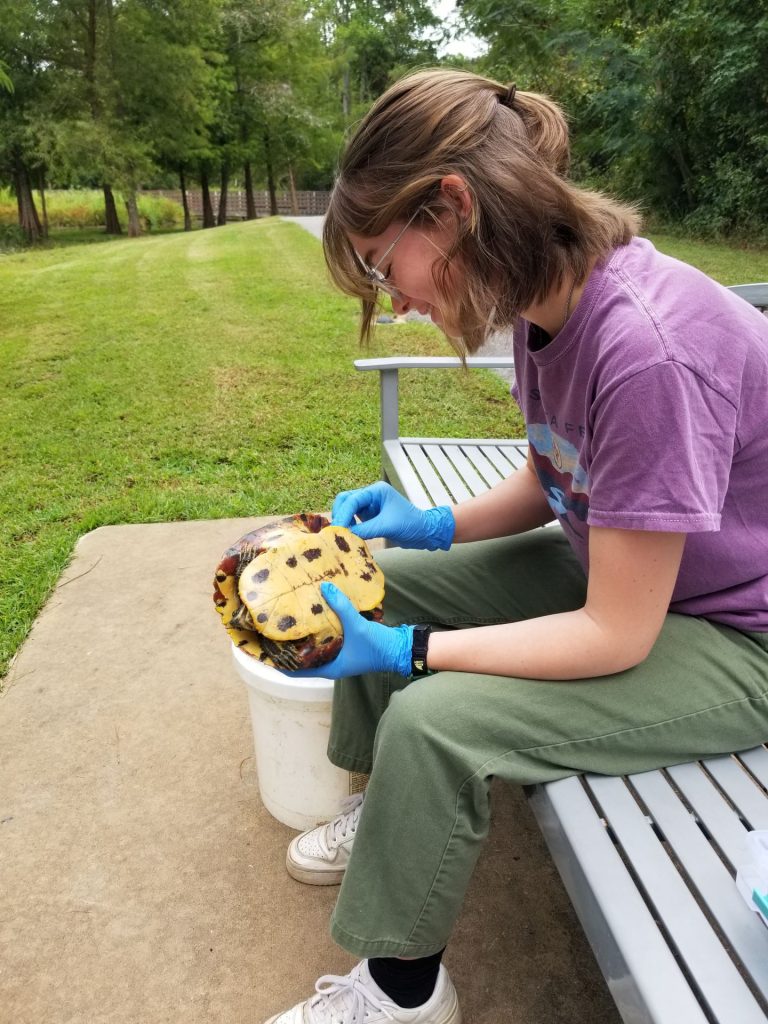
Mate choice is central to sexual selection, and there is a lack of knowledge regarding male mate choice specifically, despite it being one of the drivers of adaptive evolution and speciation. Mate choice studies have scarcely been conducted in turtles because of the difficulty of observing mating behaviors that occur in water. With developments in technology, observing potential patterns in male mate choice in freshwater turtles has become increasingly feasible.
Using two 3D-printed female decoys of differing sizes, we are testing whether male yellow-bellied slider turtles (Trachemys scripta) prefer to interact with females of larger sizes over smaller sizes when given a choice between the two. Each decoy is fixed with a passive integrated transponder (PIT) tag reader that records when previously PIT-tagged males approach either decoy within close range (<40cm). By choosing a female of larger size, males should increase their reproductive success due to body size being associated with increased fitness. This novel approach to mate choice study offers a realistic context in which observing mating behaviors in the wild is feasible with conditions that are not traditionally ideal.
McKae Sarkowski, a Junior majoring in Organismal Biology Ecology, Evolution, and Behavior in the College of Sciences and Mathematics is a 2023-2024 Undergraduate Research Fellow. Her mentor is Matthew Wolak, in the Department of Biological Sciences.
William Bozeman
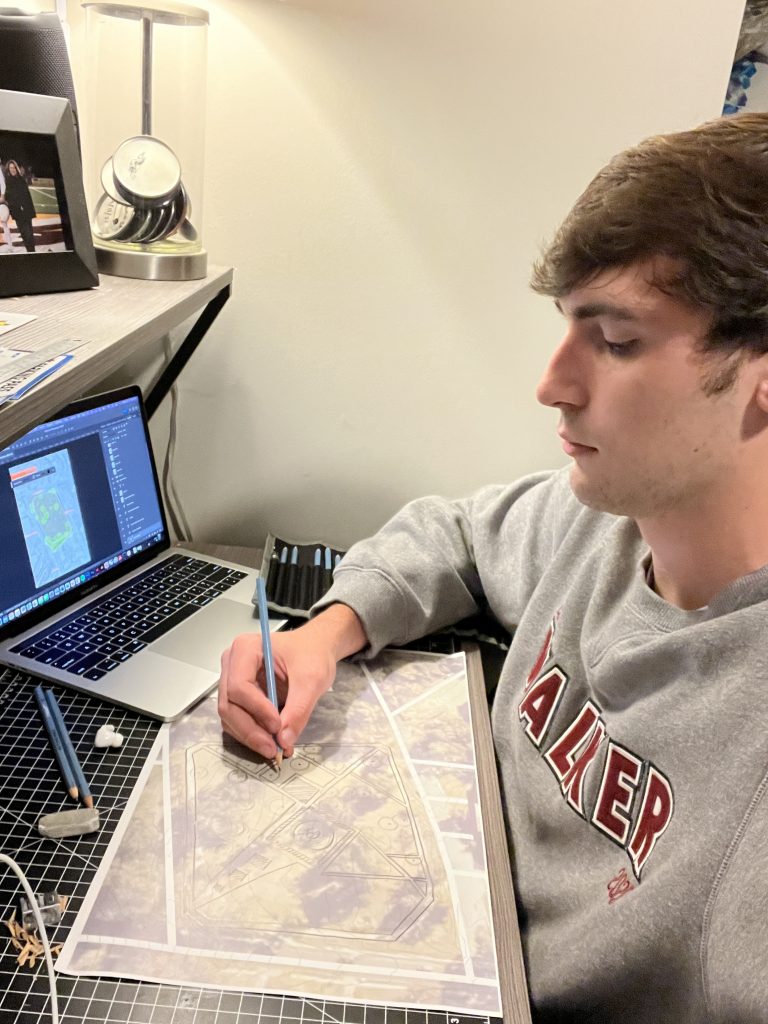
Surrounding one’s environment with nature activates the parasympathetic nervous system and the sympathetic nervous system, which promotes mental health. The “Green Mind Theory,” connects the body with natural and social elements. The constant presence of natural elements is proven to be beneficial to the brain and body as a whole. The brain is split up into two main categories when examining its interaction with nature, the top and bottom brain. This “Green Mind Theory” is a product of the activated parasympathetic nervous system (top brain) along with the sympathetic nervous system (bottom brain). The benefits vary in quantity depending on the user’s focus, attention, awareness, and immersion. Benefits can also include longer lasting memories, which occur when neurons are created by the hippocampus as a reaction to an enriched environment. While natural spaces are beneficial to everyone, they can be designed in a way that is especially beneficial to those with mental disabilities. Sensory gardens provide a wide range of sensory experiences for users to interact with. This includes different features, surfaces, objects, and plants to stimulate the human senses. While normal gardens utilize senses in everyone, these gardens are specially designed and tailored to the needs of those with special needs. Research shows that sensory gardens are most successful when interacted with in stations. This also allows children to be more social and interactive. Sensory gardens are more beneficial to these students than regular gardens and are engaged with in significantly higher quantities.
Will Bozeman, an Environmental Design major in the College of Architecture Design and Construction is a 2023-2024 Undergraduate Research Fellow. His mentor is Kelly Homan, in the Department of Environmental Design.
To read his full highlight in AUJUS, click here.
Chase Hoytink

In the face of rising climate change concerns, the use of nature-based infrastructure becomes a promising solution to slow the process of rising sea levels through coastal resilience design. This research explores the transformative role that drawing takes in expressing these solutions. Using softwares such as Photoshop, Illustrator, and Rhino, these drawings help conceptualize infrastructure that focuses on integrating nature-based design into coastal design. The coast is especially vulnerable to climate change. Rising sea levels and infrastructure development cause damage in many coastal communities. Through NOAA ESLR (Effects of Sea Level Rise Program) engineers and landscape architects work together to address sea level rise through a series of nature based solutions to mitigate those effects. Drawing and digital representation offer a way to visualize what is happening to the coast and develop design concepts effectively. As nature-based infrastructure gains traction as a solution to rising sea levels, focus on drawing and digital representation in the field remain notably underexplored. The objective of this research is to explore digital software, test various ways to set up a drawing, and learn new representational strategies. Four methods are being tested for when it comes to the set up of a drawing. Collages prove effective in representing spatial sequencing and capturing the region’s landscape through a series of altered photographs. Ecological Transects cut across various regions across the Fort Morgan Peninsula, displaying landscape elevation, plant communities, and significant site points drawn through technical line work. Typology analysis categorizes the infrastructure of the peninsula, organizing parcels of land from dynamic to fixed, showing the quality of land through a series of technical, yet illustrative drawings. Lastly, perspectives showcase the overall character of the region through a more illustrative lens. Research shows that nature-based drawing plays a crucial role in collaboration, enabling a deeper understanding of the designs
Chase Hoytink, a Junior in Landscape Architecture major in the College of Architecture, Design and Construction is a 2023-2024 Undergraduate Research Fellow. Her mentor is Rob Holmes, in the Department of Landscape Architecture.
Click here to read Chase’s research highlight article published in the Auburn University Journal of Undergraduate Scholarship.
Morgan Young
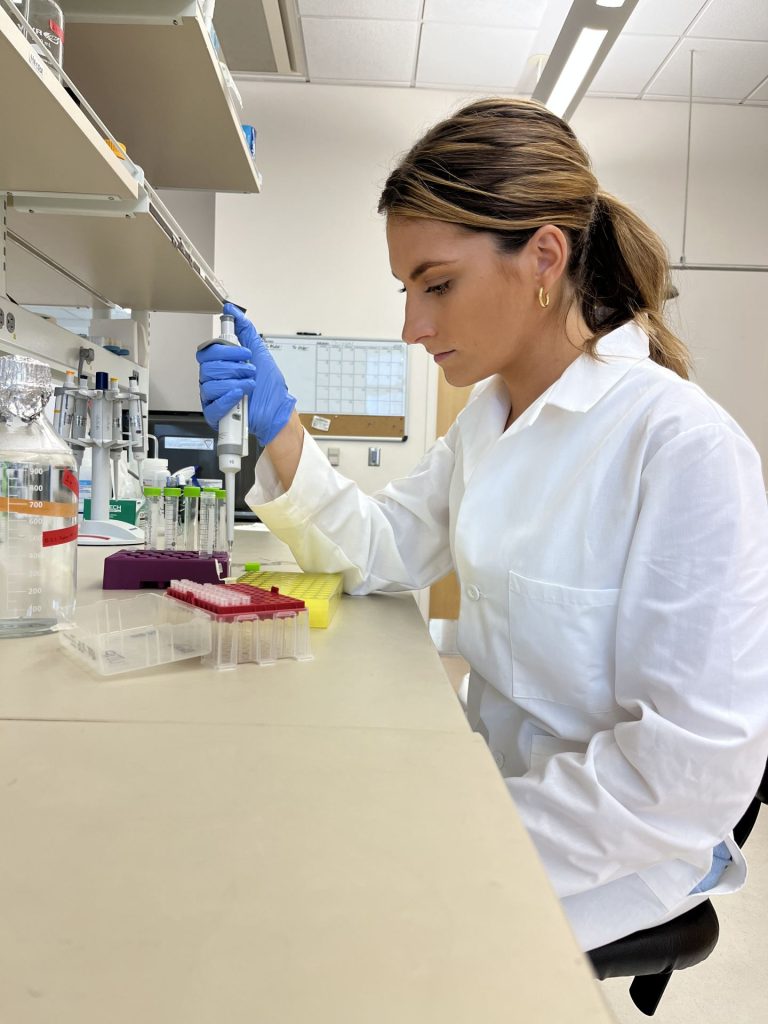
In the cow-calf industry, unexplained infertility remains a costly issue. If a heifer fails to become pregnant after reaching full reproductive maturity and having multiple opportunities, the cost that it took to raise that heifer is not fully recovered. Usually, replacement heifers are chosen based on genetic and phenotypic qualities. These methods can be useful, but in some cases heifers still fail to become pregnant following their first breeding season. To examine this issue, a group of heifers were put through an estrous synchronization and artificial insemination (AI) program, followed by natural service for two additional estrous cycles. The heifers were then grouped as fertile (pregnant from AI) and sub-fertile (failed to become pregnant). In past research, using samples from heifers, the Dyce lab has identified possible RNA based molecular targets that were expressed differently between the fertile and sub-fertile heifers. In this project, endometrial samples were collected following the breeding season from heifers deemed fertile and sub-fertile. The protein level expression in the tissue was investigated using Western blotting techniques. The antibodies for the markers of interest were used and the quantities were compared between the two groups of heifers. This analysis was done using Image Lab software and analyzed with a t-test. Based on the results, there was no significant difference (P > 0.05) between the two groups for any of the selected antibodies. The objective of this research is to investigate the differences in protein expression in the endometrial tissue with candidate antibodies between the two groups of heifers with differing reproductive potentials, as well as the acquisition of laboratory and research skills
Morgan Young, a Junior majoring in Animal Science in the College of Agriculture is a 2023-2024 Undergraduate Research Fellow. Her mentor is Paul Dyce, in the Department of Animal Science.
Click here to read Morgan’s research highlight article published in the Auburn University Journal of Undergraduate Scholarship.
Jordan Fluker
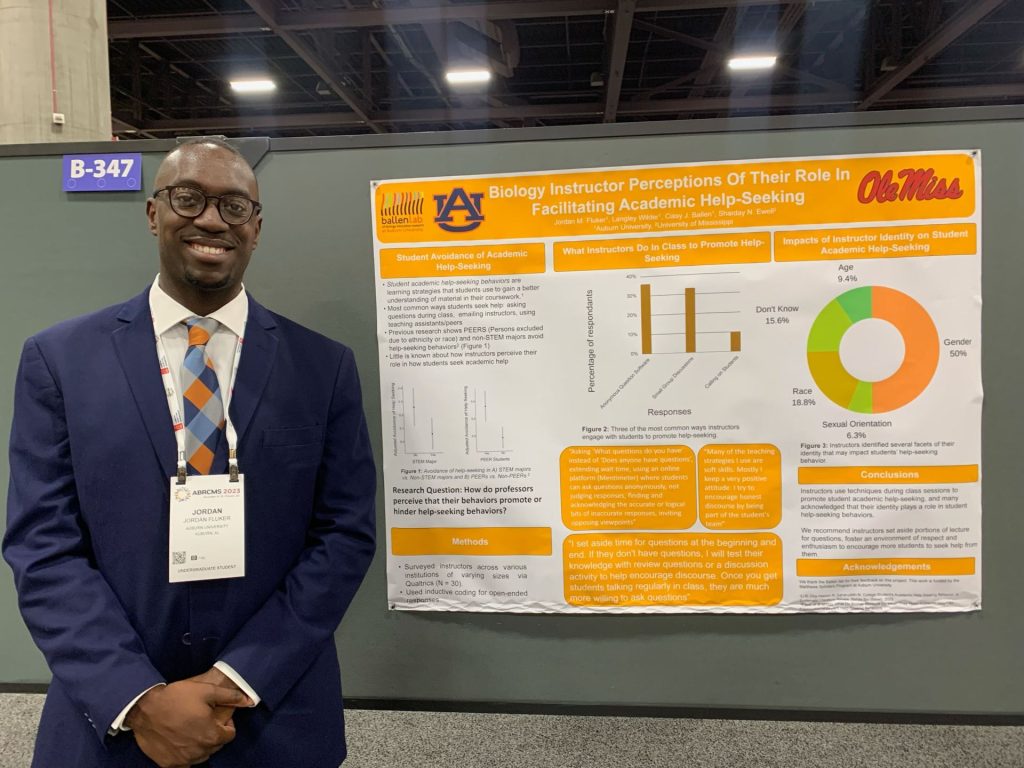
Help seeking behaviors are learning strategies that students use to gain a better understanding of material in their coursework. These can include attending office hours, study sessions with classmates, and using outside resources. Historically, persons excluded due to their ethnicity or race (PEERs) are more reluctant to pursue help seeking behaviors than other students in their courses. Previous research from the lab demonstrated that students enrolled in four different biology classes perceive that they need help understanding the course content. However, while students feel verbally encouraged by instructors to seek help, students who identify as PEERs are more likely to avoid seeking help when they need it.
Furthermore, if student do seek help, they prefer to ask their peers for assistance due to their perceived accessibility. To further examine the role of instructors on academic help-seeking, we asked how professors feel that their behaviors impact students’ academic help seeking. Jordan’s overarching research question asks, “How do professors perceive that their behaviors promote or hinder help seeking behaviors?” We distributed a voluntary survey to professors from roughly 75 institutions of different sizes and research levels to examine how they feel they encourage or discourage student academic help-seeking. 60 instructors responded to the survey, and we analyzed open ended responses using thematic analysis. We found that most instructors attempt to promote academic help-seeking through verbal encouragement (e.g., inviting students to office hours) or pacing instruction (e.g., setting aside class time to answer questions, use of iClickers). These methods are like the actions that made instructors feel supported when they were students. We also found that many instructors believe that their identity impacts students’ willingness to seek help from them. This includes gender, ethnicity, and age. Specifically, when instructors and students have a shared identity relationship, instructors perceive that this positively impacts their relationship with students. Male instructors feel that they have a harder time connecting with students due to them possibly being intimidating to students. These foundational data will illuminate how instructor perceptions and expectations of help-seeking encourage or discourage student behavior in undergraduate biology.
Jordan Fluker recently attended the Annual Biomedical Research Conference for Minoritized Scientists (ABRCMS). While at the conference, he had the opportunity to network with researchers and students while learning more about pursuing research at the graduate level. He attended the conference for 3 day and listened to key note speakers on various topics ranging from career preparation to advancements in cancer research. Jordan stated “ABRCMS has given me the tools to better conduct research in the future as well as provide avenues to conduct research post graduation.”
During his time there, he presented a poster to discuss how biology instructors perceive their impact on student academic help-seeking.
Jordan Fluker, a Biomedical Science major in the College of Science and Mathletics is a 2023 Undergraduate Research Fellow. His mentor is Margaret Ballen, in the Department of Biological Sciences.
Smith Strain
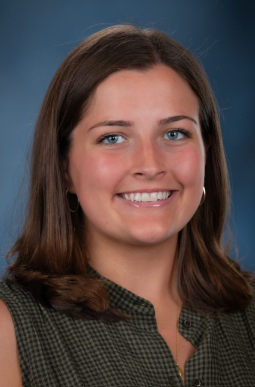
Smith Strain’s research focused on how women’s experiences contribute to their decision to stay in the physics discipline. Women continue to be underrepresented in physic despite recent developments focusing on improving representation and equity. There have been several recent research projects focusing on the experiences of women and women of color within the physics discipline however, it is not clear how certain factors contribute to women deciding to stay within the field or to leave for another discipline. For Smith’s research study, 5 women’s experiences were investigated to understand what experiences contributed to them staying within the field or choosing another discipline. It was found that lack of support was the most prominent feature when making the decision followed by poor treatment and interests within physics. Smith’s research highlights the need for women within the physics department.
Smith stated the most rewarding part of conducting research was knowing that her research will be used for years to come. She said “Knowing that I am apart of something much bigger than myself has impacted my life as a student, and has motivated me to continue pursuing, investigating, and writing about adversities women face within the physics and STEM community.” She explained that conducting research has created a new appreciation for articles or journals that she reads now because she understands the hard work that was put into each project and no two projects follow the exact same steps in the process. She said most importantly: “I want future fellows to know that this is one of the most unique opportunities you will ever have, and to be published in academia is a high honor that sets you apart!”
Smith Strain, a Civil Engineering major in the Samuel Ginn College of Engineering is a 2023-2024 Undergraduate Research Fellow. Smith’s undergraduate research faculty mentor was Dr. Eric Burkholder, from the Physics Department in the College of Sciences and Mathematics.
Benjamin Welsh
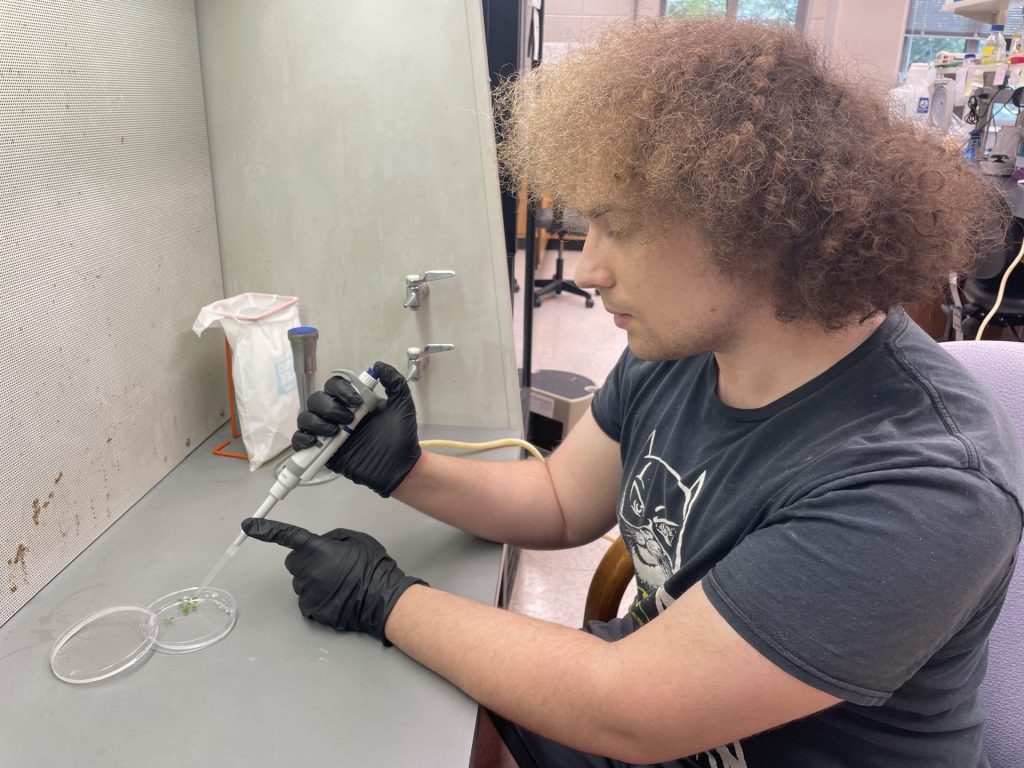
Phytoparasitic nematodes (PPN) are a significant and common pest that devastate global and local crop yields, as they account for around a 10% loss of crops worldwide. Although chemical nematicides have been used to alleviate potential damage from PPN, nematicides may be toxic to the environment, animals, and humans, as well as not being cost-effective for use on most crops. Therefore, an inexpensive tolerant cultivar could solve the various problems that PPN and nematicides pose.
This study attempts to identify which biological pathway is vital in a plant defense response to PPN so that a genetically modified cultivar can be developed. In the past, studies have pointed toward salicylic acid (SA), a major plant defense biopathway, which is thought to be the main agent in plant defense against PPN on the assumption that as SA fends off various microorganisms through a hypersensitive response (HR), which involves apoptosis to eliminate infections, it should fend off PPN as well. Crucially, nematodes are animals, not microorganisms, and the dead cells produced by HR could be beneficial to PPN. Root hairs and reactive oxygen species seem to be major factors for a plant’s defense against PPN based on Benjamin’s research group previous studies of cotton roots introduced to PPN. Oxo-phytodienoic acid (OPDA) is a critical regulator in the development of root hairs and is a precursor to jasmonic acid, another major plant defense biopathway.
In this study, various genotypes with knockouts of major plant defense genes in Arabidopsis thaliana were grown and inoculated with Meloidogyne hapla, a common root-knot nematode. Benjamin’s research group preliminary results show that the 2CPA (a gene vital for the detoxification of H2O2) knockout has more root galls, knots that Meloidogyne hapla makes, than the wild type. While this study is still ongoing and cannot be conclusive, both 2CPA and CYP20-3 (a receptor needed for OPDA) might be critical in a plant defense response to PPN.
Benjamin Welch, a Sophomore who majored in Applied Biotechnology in the College of Agriculture was a 2022-2023 Undergraduate Research Fellow. Benjamin’s undergraduate research faculty mentor was Dr. Sang-Wook Park.
Melissa Freeman
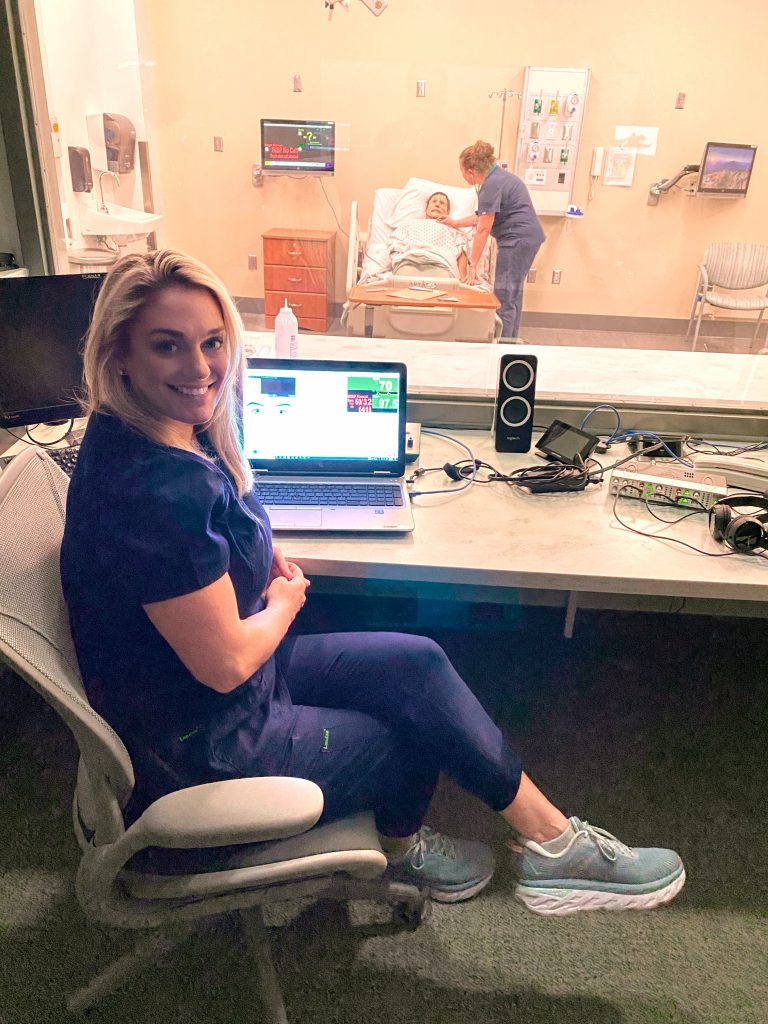
Accurate collection of assessment data obtained by nurses, nursing students, certified nurse assistants (CNA), and unlicensed assistive personnel (UAP) plays a critical role in the early detection of patient deterioration. Obtaining accurate vital sign data, timely documentation, and the implementation of clinical bundle protocols for patient deterioration requires clinical experience and sound nursing judgment.
The objectives of this study are to determine: if routine assessments by clinical staff include vital sign data, if collected data is accurate, and if data obtained by licensed nurses has higher accuracy rates than UAP, including CNAs. This study examines a potential correlation between the respondent’s attitude toward the data and the accuracy of the data collected. A two-part model is utilized to study assessment techniques, data accuracy, and the respondent’s attitudes toward the data. High-fidelity mannequins are utilized in a simulation environment to assess the method of collection and accuracy of vital sign data collected by licensed and unlicensed nursing staff. The V-Scale is then administered to measure the respondent’s attitudes toward vital sign monitoring to identify potential knowledge, attitude, and skills deficits. Data collected suggests that licensed nurses and nursing students understand the importance of vital sign assessment but find the task repetitive and time consuming, leading to poor clinical performance and inaccuracies in data collection. Data further suggests that CNAs and UAPs may lack the education and clinical judgment necessary to appreciate the need for accuracy and recognize abnormal findings on a per-patient basis, delaying the implementation of clinical deterioration bundles.
Overall, this limited study indicates a correlation exists between the attitude toward and the accuracy of vital sign assessment. Future research on a larger scale is necessary to confirm the correlation.
Melissa Freeman, a Senior who majored in Nursing in the College of Nursing was a 2022-2023 Undergraduate Research Fellow. Melissa’s undergraduate research faculty mentor was Dr. Pao-Feng Tsai.
Charlotte Jannach

Understanding what factors affect an individual’s groundwater knowledge and their water perceptions is essential to finding the gap where this knowledge is not being learned. Groundwater knowledge is essential to every career pathway ranging from knowledge about its contamination being important in the medical field to knowledge on how it should be properly used being important to policies about groundwater use in the government. A study conducted in 2013 analyzed University of Florida’s student body’s environmental risk perceptions and environmental attitudes (Carlton, 2013).
Charlotte’s research aimed to determine what factors influence groundwater knowledge. Auburn University’s student body was surveyed about potential factors that may contribute to an individual’s perceptions and knowledge on water. This Qualtrics survey included groundwater knowledge questions, contamination awareness questions, personal experience questions, and demographic questions.
Results showed there was no significant difference in year in college or if an Earth Science course was taken in high school. However, there was a statistical difference in knowledge scores when comparing colleges (College of Agriculture, College of Pharmacy, College of Science and Mathematics and Samuel Ginn College of Engineering were used). There was also a significance in knowledge for those who had taken an Earth Science course in college compared to those who did not.
Further questions that Charlotte believes should be studied more include “Why is groundwater knowledge being successfully learned in college courses but not in high school classes?” and “How would students from other colleges, who may end up working on groundwater projects, scored compared to the college analyzed?” She believes these would be important areas to focus on in the future to understand how to effectively teach certain audiences and how to prepare people who will in the future work closely in that field.
Charlotte Jannach, a Senior who majored in Geology in the College of Science and Mathematics was a 2022-2023 Undergraduate Research Fellow. Charlotte’s undergraduate research faculty mentor was Dr. Ann Ojeda.
Collins Keith
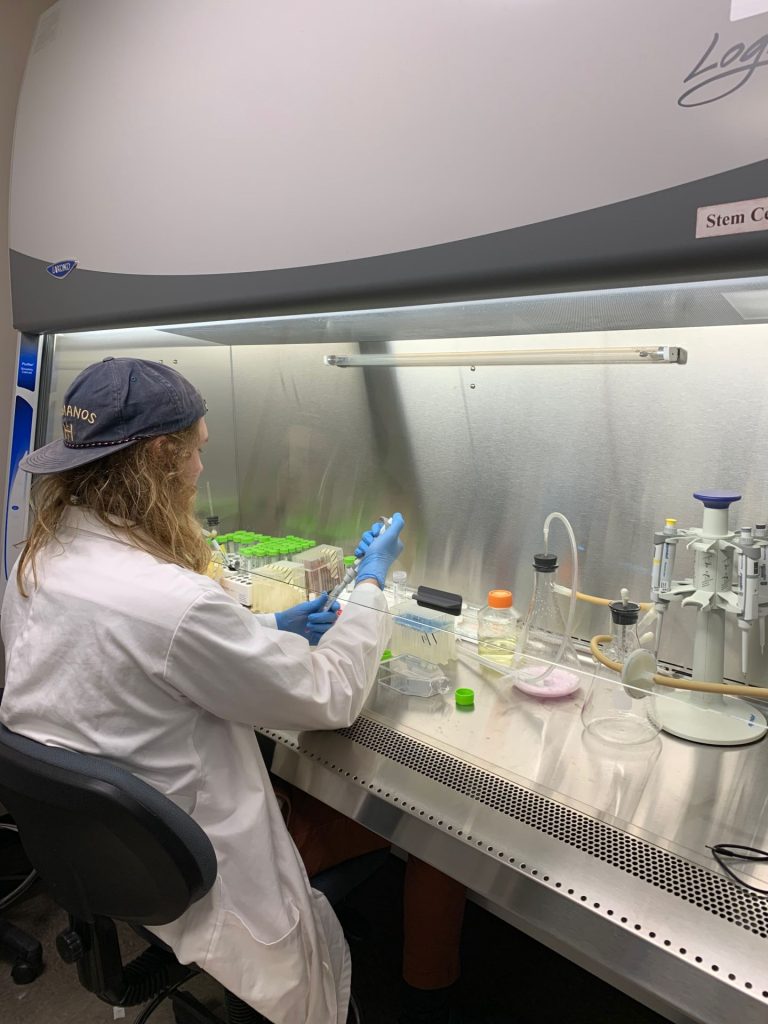
In the normal progression of cancer, the establishment of secondary tumor sites in the patient’s body, or metastasis, is associated with lower survival rates and treatment efficacy. This transition, incited by the detachment of cancer cells from the primary tumor site, sees cells move through confined spaces: channel-like tracks that vary from 3-30 micrometers in width. Understanding the mechanisms of a cancer cell’s movement from a primary tumor through these small passages in our tissues and blood vessels is critical to improve the efficacy of patient treatment.
How cells sense and respond to confinement is not well understood. Reactive Oxygen Species (ROS), a class of molecules associated with cellular respiration, can cause DNA damage in excess with profound consequences on genomic integrity. Although ROS levels increase in confinement, the impact of this increase on the modes and mechanisms of confined cell migration remains unclear.
To address this gap in knowledge, human fibrosarcoma cells and human dermal fibroblasts were seeded into polydimethylsiloxane-based microfluidic devices, consisting of arrayed, parallel channels with a fixed length and width (200 μm and 10 μm) and a variable height of 3 or 10 μm (confined/unconfined). N-acetylcysteine (NAC) in 10 μM was used to inhibit ROS. Time-lapse microscopy was used to image cells on an inverted Nikon Ti-2 microscope. Images were taken of cell migration, after fixing and staining of cells to visualize actin polarization and nuclear integrity, and of ROS localization. Results were analyzed using ImageJ and MATLAB. The results revealed that inhibition of ROS increased cellular migration speeds and markedly suppressed membrane bleb formation, causing cells to preferentially exhibit protrusive-based migration phenotypes. This was observed in confined but not unconfined channels. Furthermore, treatment with NAC reduced the extent of nuclear blebbing, suggesting that ROS promotes nuclear deformation and presumably nuclear envelope rupture which may have detrimental effects on cell survival. Our future studies will focus on delineating how ROS regulates the efficiency and mechanisms of confined cell locomotion. Collectively, these findings reveal the key role of ROS in confined cell migration and suggest that overactivation of ROS may represent a novel approach to suppress cancer cell migration in vivo.
Collins Keith, a Senior who majored in Chemical Engineering in the Samuel Ginn College of Engineering was a 2022-2023 Undergraduate Research Fellow. Collin’s undergraduate research faculty mentor was Dr. Panagiotis Mistriotis.
Caroline Sanders
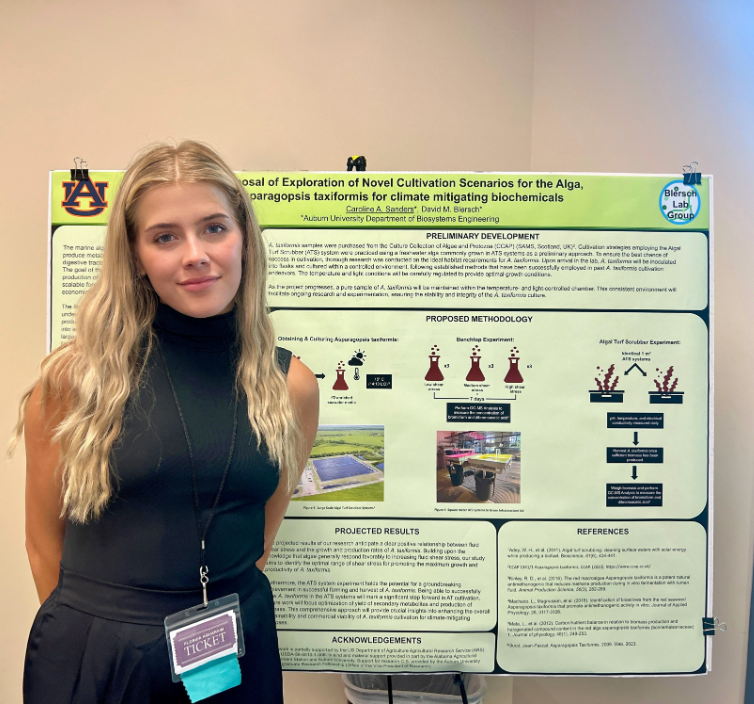
The marine alga Asparagopsis taxiformis (AT) has been shown to produce metabolites that are anti-methanogenic in ruminant digestive tracts, but large-scale cultivation of AT remains elusive. The goal of Caroline Sanders research project is to optimize the growth and production of AT’s antimethanogenic secondary metabolites in a scalable format of an algal turf scrubber (ATS) approach to find an economical approach to farming AT.
The first objective is to conduct a bench-top experiment over the course of 7 days to understand the effect of fluid shear stress on AT growth and production. The second objective is to adapt the AT into an ATS system and investigate its response to cultivation at a larger scale. Additional experiments will explore the effects of lighting intensity, flow rate, and nutrient concentrations on growth and secondary metabolite production. The projected results of the research are predicted to be a positive relationship between fluid shear stress and the growth and production of A. taxiformis. The study hopes to identify the most optimal range of shear stress that promotes growth and production.
Caroline is working in the Algae Systems and Ecological Engineering Lab for her research and is looking to have a career in either water treatment or agricultural engineering. She stated the most rewarding part of her research this far is having an individualized learning experience and one on one learning with her mentor. It deepened her knowledge of her field and specific research interests. “This opportunity has taught me about the importance of being confident in your work.” Caroline also said that attending and presenting at a conference was a huge confidence booster. “You may be the youngest and most underqualified in the room, but you’re in the room and that’s a big deal. I realized how my imposter syndrome was holding me back and how confidence is the key to success.” Caroline recently presented her research at the Annual Meeting of the American Ecological Engineering Society, in Tampa, Florida on June 6-9, 2023. Next year, she plans to present her final results at the same conference. Being able to present at a conference is a huge accomplishment within an area of research. Caroline is thankful for the time management and teamwork skills and personal responsibility that she has learned through the research process.
Caroline Sanders, a senior in Biosystems Engineering, is a 2023 Undergraduate Research Fellow. Her Mentor is Dr. David Blersch.
Olivia Price

Online streaming and multimedia filming of Tabletop Role-Playing Game (TTRPG) Actual Play has become immensely popular in recent years. The invisible labor practices in designing,
producing, and distributing these shows is mostly obscured from viewers, despite these processes being integral to the form.
As TTRPG Actual Play joins the entertainment industry in television and film deals, the invisible labor conducted behind the scenes has become exponentially more relevant. Olivia Price’s study mainly consists of information obtained through interviews and site visits with industry professionals. These practitioners offered insight on their labor processes, material necessities, noticed trends, and expectations for the future of Actual Play. A bibliography of resources has been started through the collection of academic articles, peer-reviewed works, social media interactions, and other mediums through which the Actual Play community communicates.
The study has found that the labor frameworks in use are largely informal and reminiscent of those in theater, television, and film settings. Industry professionals who produce Actual Plays are often members of these other entertainment communities, which fuse closer together as the industries progress. New frameworks for invisible labor continue to form and be revealed as the Actual Play production community develops, further encroaching into television and film. Lifting the veil that separates the viewer from the labor has illuminated the economic and academic potential of this field in terms of production frameworks, entertainment, live performance, and viewership. This study will serve as the basis for future investigations of invisible labor in Actual Labor, providing a vocabulary and expectations for continued exploration.
Olivia Price, was a senior who double majored in English and Theatre and Dance. Olivia was a 2022-2023 Undergraduate Research Fellow. Her mentor was Dr. Emily Friedman.
Abigail Cox

College students are heavily impacted by mental health as growing trends indicate a crisis with mental health. Mental health problems in college students can affect academic attainments, social patterns, and quality of life. A large amount of college students are experiencing a decline in their mental health and subsequently other areas in their life.
The objectives of Abigail’s review were to explore the literature on mental health in college students and Auburn University’s data regarding students’ welfare and to determine strategies to improve college students’ mental health. These were investigated at both the individual and systematic levels.
Abigail conducted a systematic review of the literature using the databases CINHAL, Medline/PubMed, Academic Search Premiere, and the website for the organization Active Minds. The keywords entered during the review to select the articles were college students, mental health, anxiety, health survey, depression, young adult, and universities.
After a review of 8 articles, five articles were included. All of the studies focused on college student’s mental health, with four of those studies providing interventions that could improve college students’ mental health (CSMH). According to Abigail’s findings, the most common interventions included implementing exercise, routine, and socializing. Feeling a sense of belonging was a significant indicator of good mental health, suggesting that socializing and connecting were among the most critical factors in mental health. Different-based interventions also varied in their effectiveness, depending on the individual, and, when combined, demonstrated a high level of success in obtaining better mental health. It is clear there is a need to further investigate this topic, said Abigail, in order to deduce what can be done not only at the individual level but at the systematic level in order to improve the quality of college students’ mental health. Auburn University would benefit from further investigation into this topic through studies expanding mental health programs. Abigail concluded that interventions can improve the mental health of college students and thus increase their success.
Abigail Cox, is a Nursing major. She is a 2023-2024 Undergraduate Research Fellow. Her mentor was Linda Gibson-Young.
Jessica Heard
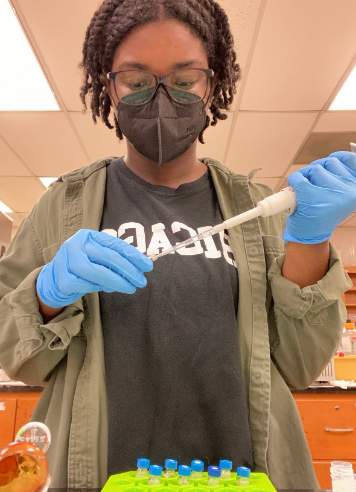
Can 3D printed implants improve the delivery of capsaicin as a means to combat obesity? Jessica Heard’s research set out to determine the answer. She thinks this is important because oral administration of capsaicin is not sustainable. It does not fully get delivered to the fatty tissue so an alternative method is needed to overcome this obstacle.
To observe this method, a intro release study was conducted to determine the duration of the capsaicin release from the 3D printed implants. The results showed that the capsaicin release from the implants was sustainable for months. This means that the implant delivery method was more efficient than orally ingesting the supplement.
Heard stated that the most rewarding part of her research project was that she gained a variety of lab skills including how to operate the 3D printers, operating multiple lab instruments 🔬, writing scientific documents and specific lab protocols. She said that this project solidified her desire to find a career path in a research🥼 lab.
Jessica Heard, a senior in Biochemistry, was a 2022 Undergraduate Research Fellow. Her mentor was Dr. Jayachandra Babu Ramapuram.
Harrison Estes
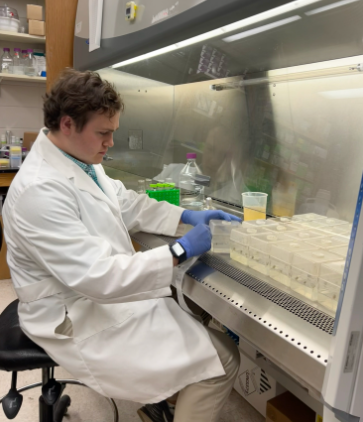
Members of the Fusarium solani species complex (FSSC) are transkingdom pathogens thought to act as either a clinical or agricultural pathogen. Previously, a single clade within the FSSC was found to contain the species most frequently responsible for human infections. Over the past several years the same species within the FSSC have been isolated from cotton and soybean fields in Alabama.
For this project, we sought to determine if isolates of the FSSC from agricultural environments could cause infections in clinical models, and if those from humans could cause disease in agricultural models. 58 FSSC isolates sourced from humans and the environment were tested in a variety of scenarios to analyze thermotolerance, minimal inhibitory concentration, and ability to grow on vegetables.
These tests showed that these isolates were able to thrive at both environmental temperature (28°C) and human body temperature (37°C). Also, the isolates were able to grow on the vegetables with varying degrees of virulence, with some clinical pathogens being more virulent than the agricultural isolates. In the future, the host range of these isolates will be further evaluated using multiple other plants, including cotton and soybean.
Harrisons stated the most rewarding thing about conducting research was “Being able to simply be in a lab and absorb the diverse things being studied around me, and made me a more complete scholar.” He says doing research and being a fellow in the program has guided him to what he is passionate about doing for his future career.
Harrison Estes is majoring in Applied Biotechnology in the College of Agriculture. Harrison is a 2022-23 Undergraduate Research Fellow, and his faculty mentor is Dr. Jeffrey Coleman.
Payton Brewer

Payton’s projects goal was to understand the impact of fire history and seed depredation on seedling emergence of four southeastern tree species. Overall, the data collected from this research will alleviate a deficit in research on the early seedling establishment and seed depredation rates of four southeastern species in unburned and burned stands. Further awareness of the early life stages of longleaf pine in relation to competing hardwood species will aid forest managers in understanding the interacting influences of fire frequency and seed predators on community assembly.
To address this question, Payton deployed several types of predator exclosures, which differentially restrict access of vertebrate and invertebrate predators, at two study sites near Auburn, AL, USA: the Mary Olive-Thomas Demonstration Forest and the Tuskegee National Forest. Within each site, three stands with no burn history and three stands that are on two year burn intervals were selected to study. Ten seeds were placed in petri dishes within each exclosure type: invertebrate only access, full access by small vertebrates, or complete exclosure. During each trial, the exclosures were monitored for seed removal rates after two weeks. Three trials have been conducted in the months of February, March, and April 2023.
In February 2023 Trial 1, we observed no significant difference in depredation rate between tree species (p = 0.3). We also observed no significant difference in depredation rate between burned and unburned stands (p = 0.4). Trial 2 and 3 are in the process of being analyzed.
Payton stated “This opportunity has given me confidence in the field, confidence, leading a group, organizing data, and communicating clearly with those above me and colleagues.”
Payton Brewer is a Senior Wildlife Ecology and Management major in the College of Forestry, Wildlife and Environment. Brewer is a 2022-23 Undergraduate Research Fellow, and her faculty mentor is Dr. Heather Alexander.
Wesley Lowman
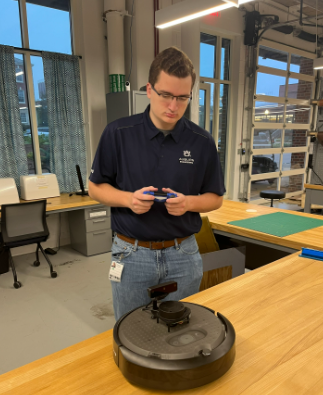
How can one create the most efficient route for an unmanned ground vehicle (UGV) and keep the vehicle on that route? This question is important because answering it can allow researchers to make new strides in ensuring the performance of unmanned ground vehicles (whether it be a robot used in disaster-recovery scenarios or a self-driving truck transporting cargo) is both safe and efficient, optimizing a multitude of processes involving UGVs. Without answering this question, the chance that UGVs cause danger greatly increases.
To address this question, Lowman designed, reconfigured and tested 9 path algorithms on 5 simulation environments with increasing complicity. Each map had 20 simulation trials run to ensure that results were consistent. This allowed Lowman to find out which path planning algorithm would provide the most efficient route in an environment.
Lowman was able to use the ros2_control framework to provide a given UGV control, and was able to successfully simulate a UGV using ROS2 and Gazebo. He found that the Theta* algorithm was the most efficient path planning algorithm and thus was the best selection to create the most efficient autonomous route for a UGV.
Lowman stated that his research bridged the gap in his knowledge between computer science and mechanical engineering. When he started this project, he had exposure to robotics, but primarily from a software development perspective. However, after this project, he has skills such as computer-aided design, ROS2, Gazebo simulation, and MeshLab – all tools that are used heavily in both industry and academia when it comes to robotics. In addition to this, his knowledge of robotic programming has greatly increased throughout his research.
Wesley Lowman is a Sophomore Computer Science major in the Samuel Ginn College of Engineering. Lowman is a 2022-23 Undergraduate Research Fellow, and his faculty mentor is Dr. Chad Rose.
2023 Newsletters
Jordan Clemmons
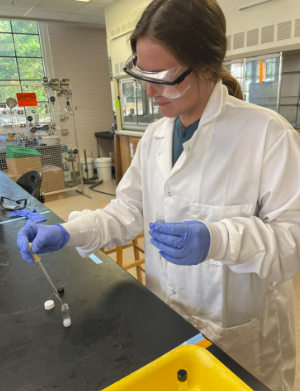
Chronic kidney disease (CKD) affects more than 1 in 7 U.S. adults, 71% percent of these people are treated with dialysis. Dialysis lowers the quality of life for patients due to the long treatment times and the stress it puts on the patient’s body. Jordan Clemmons research sets out to explore orally ingested sorbent microgels as an alternative treatment for CKD. These microgels mimic dietary fiber to absorb uremic toxins while releasing probiotics. However, a few setbacks to these gels include a lengthy gelation time and difficulty in ensuring the correct microstructure for the desired use. Self-assembly small molecules can be added to cellulose gels to tune the microstructure of the gel and ensure the correct pore size and geometry. The addition of the small molecule will also decrease the gelation time due to rapid self-assembly.
In Clemmons study, they investigate the gelation characteristics of a pH-responsive small molecule, FMOC, and its effect on cellulose-based microgel structure. Since FMOC creates a gel in a basic solution, different concentrations of sodium hydroxide were added to determine the most stable pH. FMOC was also added to a cellulose solution with urea and sodium hydroxide to explore gelation time. The FMOC was observed over a month and a pH of 12.7 was determined to be the most stable. This shows that pH will affect the stability of FMOC. When FMOC was added to a cellulose solution, a gel was instantly formed. This result confirms that a small molecule will decrease the time it takes for a microgel to fully form. Microscopy images were taken of water, FMOC, and NaOH only.
In a second solution, urea was added to the mixture. The microscopy images showed an increase in the density and connectivity of fiber networks that was proportional to an increase in pH. These images show that fiber networks present from the small molecule could eventually be used as a template to create a more uniform gel. Another finding from the microscopy images was that the samples with and without urea were very similar, showing that urea may have no effect on how FMOC interacts with NaOH. In conclusion, these findings show promise that a small molecule may be beneficial in tuning the function of a microgel and should be investigated more thoroughly. This method could make the production of cellulose microgels more feasible and could therefore change the lives of many patients suffering from chronic kidney disease.
Jordan Clemmons, is a freshman chemical engineering student. Her mentor is Symone Alexander.
Katie Griffin
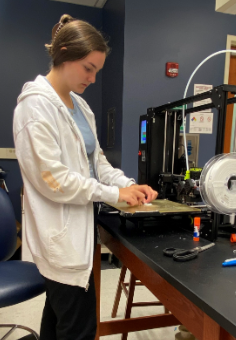
Can additive manufacturing be used to fabricate braided structures? Katie Griffin looked to answer this question by studying the growing capabilities of additive manufacturing that offer new possibilities in a variety of aspects in the textile industry.
To assess this, there first must be designs of these braided cylindrical structures created in 3D modeling software (SolidWorks). Next, the designs are 3D printed and tested for mechanical properties. It was found that these braided structures can be manufactured through 3D printing, but there are limitations in the areas of material used and similarities to traditionally manufactured braided cylinders.
During the research process, Griffin found that she enjoyed the process and design work for the 3D modeling and printing. This research project has helped her understand the capabilities of different materials and how they behave when undergoing stress. She hopes that this will pave the path to future coursework, more research in industrial application and a potential career in designing and/or 3D manufacturing.
Katie Griffin, a sophomore in Mechanical Engineering, was a 2022 Undergraduate Research Fellow. Her mentor was Dr. Sabit Adanur.
Dorothy Dreelin
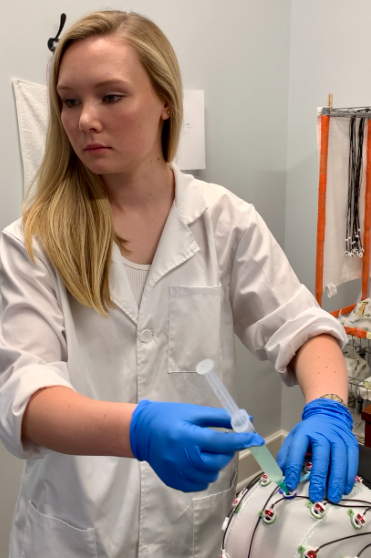
What is the role of reactivity in PTSD symptoms and how do they contribute to worse symptoms and more substance abuse? Dorothy Dreelin looked to answer what conditions result in altered threat responding in Posttraumatic Stress Syndrome (PTSS) and how it connects to other forms of psychopathology.
Participants will complete a non-invasive electroencephalogram while conducting computer tasks that evaluate reactivity and sensitivity to negative reinforcement. To measure threat reactivity, participants will complete a picture-viewing task where they are presented with pleasant, neutral, and threatening images. A shape will then flash onto the screen, and the participant must quickly and accurately press a button indicating which shape appeared. This task reflects threat reactivity and the ability to maintain attention on a goal-directed task in the context of threat. If participants have trouble maintaining attention, then they will have significantly greater brain activity approximately 400-1000 milliseconds after viewing the stimulus. Then participants will complete a two-week ecological momentary assessment where they will complete surveys four times a day regarding anxiety, mood, sleep patterns. We will invite all participants to complete a follow up appointment 3 months later, which will include another clinical interview to observe the maintenance of their PTSS.
This study is still in progress, however, Dreelin and her team hypothesize participants who struggle to maintain attention during the tasks will experience more severe PTSS and report greater substance use.
Dorothy Dreelin, a senior in Psychology, was a 2022 Undergraduate Research Fellow. Her mentor was Dr. Brian Albanese.
Katie Marlow
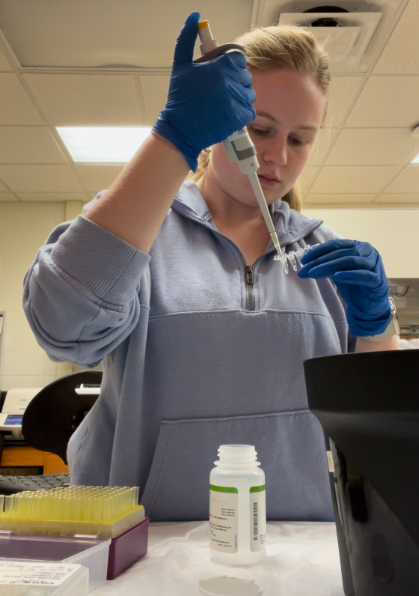
Kaite’s active research project aims to understand the pharmacogenomic biomarkers underlying variable drug responses and differences in drug metabolism genes related to Indian subpopulations that have not yet been explored. Mutational analysis was conducted to find the most damaged mutations within the genes. The most damaged part of the genes 🧬 would be the most effective to study using bacteria transformation. The last step of the project used vitro mutagenesis in cultured cell to demonstrate the effects of the genetic change. Results of Katie’s research will help understand how different Indian populations compare to others genetics to see different drug reactions and how they metabolize.
Katie’s research is still in the data analyzing phase and will continue through the Spring 2023 semester.
Katie Marlow was a 2022-2023 Undergraduate Research Fellow in the School of Pharmacy. She is mentored by Dr. Amit Kumar Mitra, PhD.
Madeline Kunze
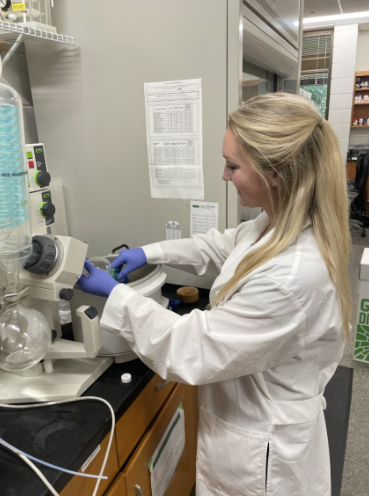
Madeline Kunze and her team aimed to create a visual bioactive molecular network for two different commercially available dietary supplements of açaí and identify which compounds are known, unknown, high bioactivity, and low bioactivity, to aid in the treatment of cancer. To look at this, Kunze used acid methanol extraction techniques and was analyzed using Global Natural Product Social Molecular Network (GNPS) and bioactivity tools. Results have revealed specific compounds with both a high and low bioactivity, which will be beneficial to creating a database with known compounds that could aid in the treatment of cancer.
When asked what the most rewarding part of her undergraduate research experience was, Kunze said that it was being able to present her research at the 2022 Auburn University Student Research Symposium and HCOP Research Showcase. Kunze stated, “My research experience has opened me up to a network of people and skills that I would not have just gained from the classroom alone.”
Madeline Kunze was a 2021-2022 Undergraduate Research Fellow in the Samuel Ginn College of Engineering, she was mentored by Dr. Angela Calderón.
2022 Newsletters
Walton Ferguson
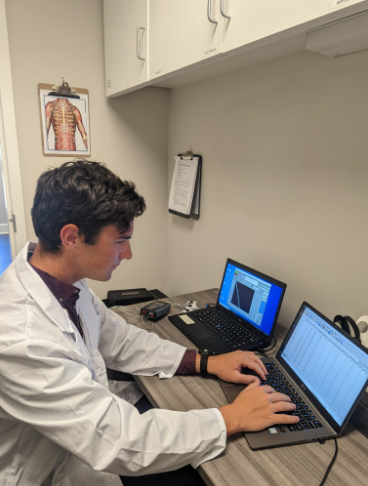
What is the relationship between interception, insomnia severity and suicidality in Military Service Members (MSM)? Walton Ferguson set out to determine the suicidality among MSM and how suicide prevention in the U.S. affect it. There are risk factors among the MSM that can make suicide more prevalent when compared to the general public. Suicide is not easy to predict so efforts shift to identifying risk factors for suicide in general are equally as relevant.
Previous research was extended to assess prominent risk factors. Archived data was collected and three time points were collected: a baseline, post test and 1 month follow-up. Suicidality and insomnia severity scores scores were found through questionnaires. A longitudinal cross-lagged model was created.
Results indicated no relationship between insomnia severity and suicidality over time. However, relationships between insomnia severity and interception as well as interception and suicidality were observed. Additionally, interoceptive dysfunction did not act as a mediator between sleep disturbances and suicidality in the model. This suggests that interoceptive dysfunction is related to suicidality, thus advancing the field closer to declaring interoceptive dysfunction as an official risk factor for suicidality.
Ferguson stated that his undergraduate research has made him realize that good, quality research 🔬 is difficult but worth the effort it takes to put in. His personal experience took some trial and error to use the best practice during his research. It has given him inside into how rewarding a successful inquiry can be. He also says that this research program has given him an opportunity he wouldn’t have experienced any other way.
Walton Ferguson, a Junior in psychology with a minor in statistics, was a 2022-2023 Undergraduate Research Fellow.
Cameron Tice
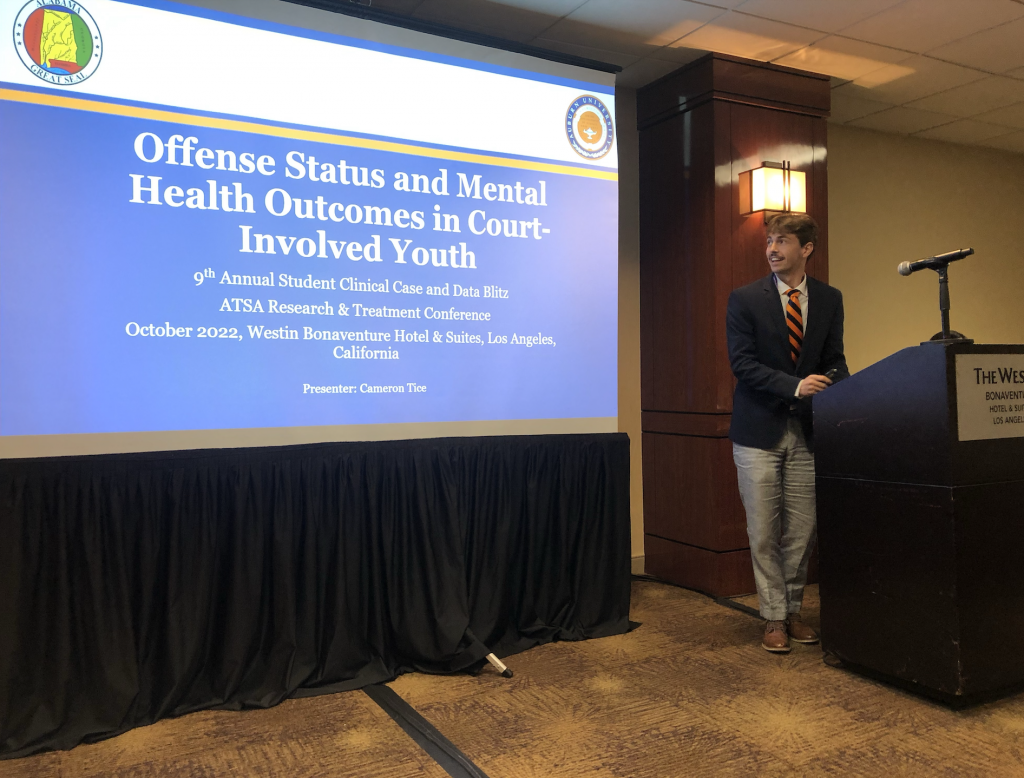
Cameron Tice aims to obtain his MD-PhD with a focus on public health. As an undergraduate researcher, Cameron has utilized the public-public research model in the Auburn University Juvenile Delinquency Lab, which is partnered with the Alabama Department of Youth Services. While providing care to these individuals, data is collected to analyze the efficacy of treatments. This method allows for continual improvements for best practice for optimal health outcomes for juvenile delinquents. Cameron is currently pursuing his MD-PhD in epidemiology with a concentration in epidemiologic statistics and social determinants of health with hopes to continue providing healthcare to inmates and gaining access to valuable insights for research. Cameron stated that the most rewarding part of being an undergraduate researcher in the Juvenile Delinquency Lab has been the greatest accomplishment at Auburn. Cameron was the inaugural first-author for the Offense Status and Mental Health Outcomes in Court-Involved Youth and presented the research at an international conference.
Cameron is a 2022-2023 Undergraduate Research Fellow in the College of Liberal Arts, he is mentored by Dr. Kelli Thompson.
Brandon Waldo

How do the genetics of gulf killifish populations in urban areas differ from those in low urban areas, based on the salinity differences? Brandon Waldo aimed to answer this question during his undergraduate research fellowship. Having an answer to this question will allow individuals to understand how populations are affected genetically, which is crucial since this influences their behavior and physiology. Using extractions of mitochondrial DNA and the genetics software Arlequin to amplify the CO1 gene, statistical analysis was performed. The results showed significant differences between the two fish populations. These differences are suggestive that urbanization-induced salinity gradients may play a part in the genetic structure of organisms that live in those environments.
When asked what the most rewarding aspect of his undergraduate research fellowship was, Waldo said that it was learning the foundational techniques and contributing real results to the field. “The process of DNA extraction and PCR amplification are almost essential to learn in the field of genetics. Understanding how they work opens the door to genetic analysis of a plethora of different species and is applicable in many potential studies.”
Brandon Waldo was a 2021-2022 Undergraduate Research Fellow in the College of Science and Mathematics. He was mentored by Dr. Moisés Bernal.
Jonathan Ting
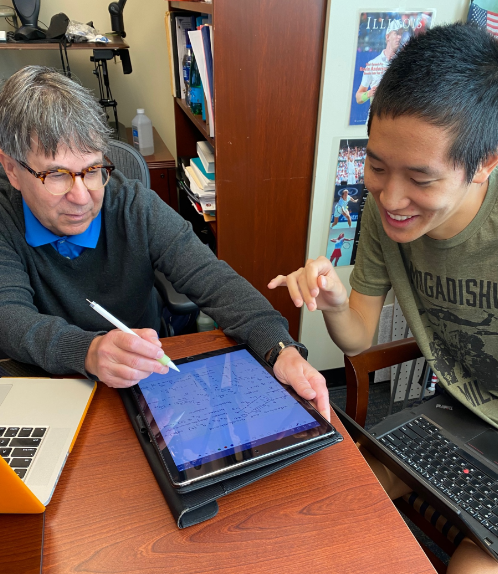
How would Sample Entropy values of signals obtained from the movement of horses vary treated different lidocaine treatments? Jonathan Ting aimed to answer this research question during his undergraduate research fellowship experience. Being able to answer this question is crucial because equine lameness poses a serious threat to the equine industry. Using sample entropy values, Ting and his team were able to qualitatively measure the lameness in equine. Results of this study showed that lidocaine 1% with epinephrine solution has a greater chance in ameliorating lameness in subjects, making it harder for veterinarians to detect lameness.
When asked what the most rewarding part of his undergraduate research experience was, Ting said that it was the opportunity to connect with professors and being introduced into the research scene. “Literature review gives me inspiration for future projects that improve people’s lives,” says Ting.
Jonathan Ting, a Senior in Mechanical Engineering, was a 2021-2022 Undergraduate Research Fellow. His mentor was Dr. Dan Marghitu.
Kate Norrid
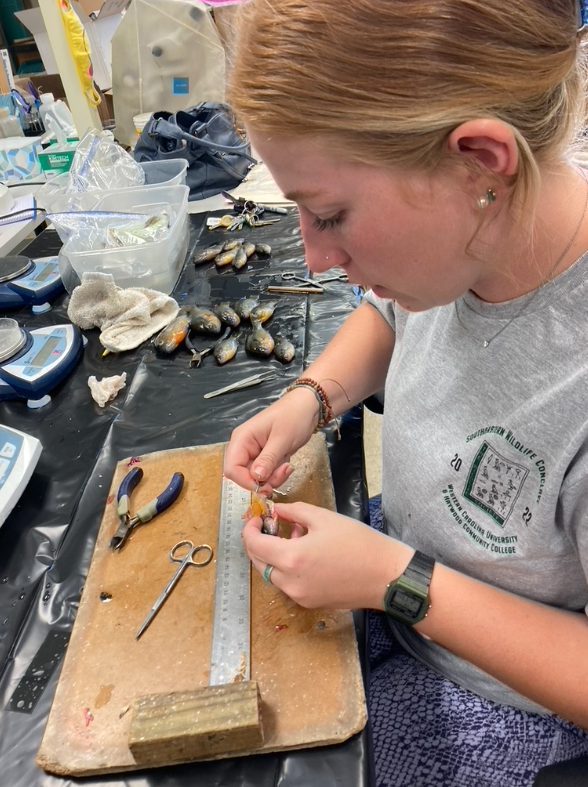
How does urbanization related water degradation affect the overall health of fish? Kate Norrid’s research focused on the answer to this question. Norrid stated that she thinks this is important because it shows how stream conservation is affected as urban development and expansion continue to occur.
To observe this method, water quality parameters were tested at multiple locations (urban vs. rural sites). There was also a collection of fish taken from each site to record physiological conditions (such a length, weight, etc.). Statistical analysis have not fully been completed but it has been found that urban stream systems have far worse water qualities when compared to rural streams.
Norrid stated that the most rewarding part of her research project was gaining experience outside her major field of study and having the opportunity to apply that knowledge following graduation. She said that this project solidified a post-graduate job.
Kate Norrid, a senior in Wildlife Ecology & Management, was a 2022 Undergraduate Research Fellow. Her mentor was Dr. Graeme Lockaby.
Susan Lott
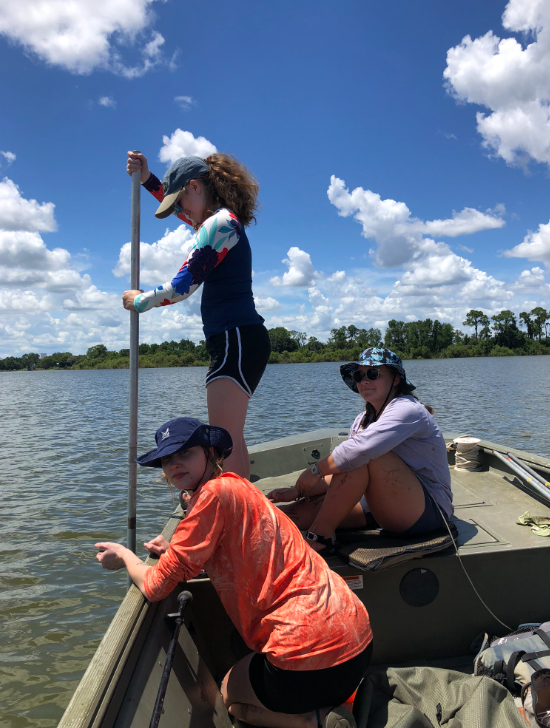
Does phosphate mining affect the algal (an overgrowth on algae) community within lakes? Iott set out to search for this answer. She thinks this is a very important factor in studying eutrophication in Florida lakes due to many of the lakes being rich in hypereutrophic and the geology is naturally phosphorus rich.
To assess this, Iott used a paleolimnological technique to observe the algal community over an allotted time to observe the nutrients and photosynthetic pigments deposited in the sediment found in the lake🔬. It was found that Banana Lake (near Lakeland, Florida), there was little to no effect of nutrient changes on the algal community. However, it was found that in surrounding shallows directly next to phosphate mines⛏️, there were hypereutrophic lakes. This means that there is a surplus of nitrogen and phosphorus in the body of water. This leads to overgrowth of algal blooms, lack of oxygen in the water and dead zones for aquatic animals known as eutrophication. In these areas near the phosphorus mines, it was discovered that there may be no point in attempting to manage these areas as the eutrophication is so significant.
Iott’s most rewarding part of research was being able to present it at research conference. It also helped her learn about the importance of water resources, environmental science and waste management. She hopes that this will pave the path to future opportunities like research and consulting jobs.
Susan Iott, a senior in Environmental Science, was a 2022 Undergraduate Research Fellow. Her mentor was Dr. Mathew Waters.
Toby Crump
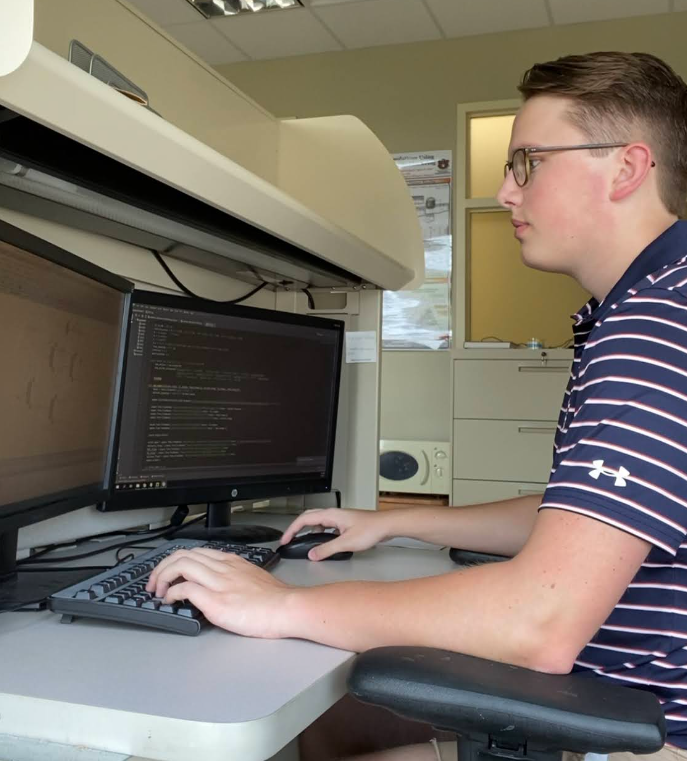
Solvent selection for solvent-based distillation (S-HDS) is a very important step, but the current solvent selection methods are either solely based on physical properties, which may lead to unfavorable choices, or may be too complicated to apply. Toby Crump, a sophomore majoring in Chemical Engineering, aimed to answer this question during his undergraduate research fellowship. Crump states that his goal is to develop and validate a fast solvent evaluation model to pre-screen separation processes for the best possible solvent. To conduct this research, Crump used different case studies, process simulation software Aspen Plus, and a derivative-free optimization algorithm formulated in Python. Results obtained showed new possible issues with the fast solvent evaluation model that have not been encountered before. Crump stated that this model will be adjusted to account for these new issues.
When asked what the most rewarding aspect of his undergraduate research fellowship experience was, Crump said that it is seeing how much he has learned from the beginning. Crump stated that his experience has given him great exposure to the field of chemical engineering, and it will help him pursue his career. “Research has shown me how complex and challenging, but rewarding computational chemical engineering can be.”
Toby Crump was a 2020-2021 Undergraduate Research Fellow in the College of Engineering, he was mentored by Dr. Selen Cremaschi.
Gabby Thompson
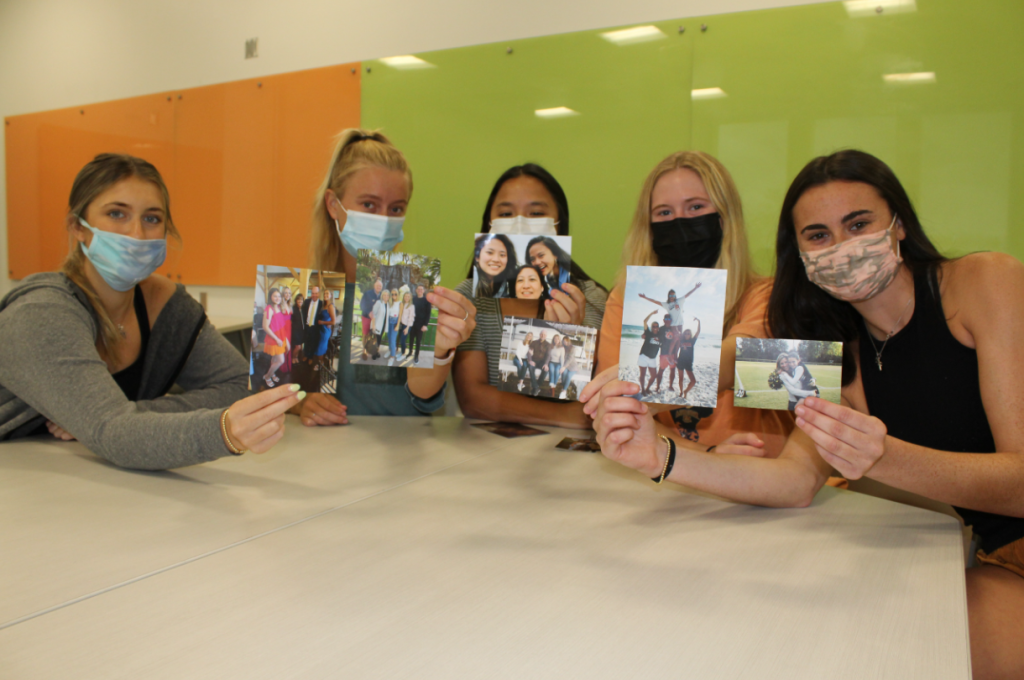
How do the most impactful people in our lives, our guardians, influence first year college student’s social interactions? Gabby Thompson focused on answering this question during her undergraduate research fellowship. “Making relationships and socially interacting with others is a key component to making the transition to college an easier and more enjoyable process,” stated Thompson. After reading countless articles and journals, receiving constructive feedback, and from the help of peers, Thompson was able to create a Qualtrics survey to send out to the incoming Auburn University freshman class. After completion of surveys and data analysis, the results showed that the life lesson that were given by students’ guardians throughout their lives have helped participants with the impactful journey of transitioning to college.
When asked what the most rewarding aspect of her undergraduate research fellowship experience was, Thompson said that it was getting genuine responses back from participants about a topic that she has always been passionate about. “This experience has allowed me to see that people are a sum of their total experiences, meaning that through every action, feeling, and behavior we have gone through, we form into the product of those experiences.”
Gabby Thompson was a 2021-2022 Undergraduate Research Fellow in the College of Liberal Arts. She was mentored by Dr. Sara Driskell.
Peyton Gober
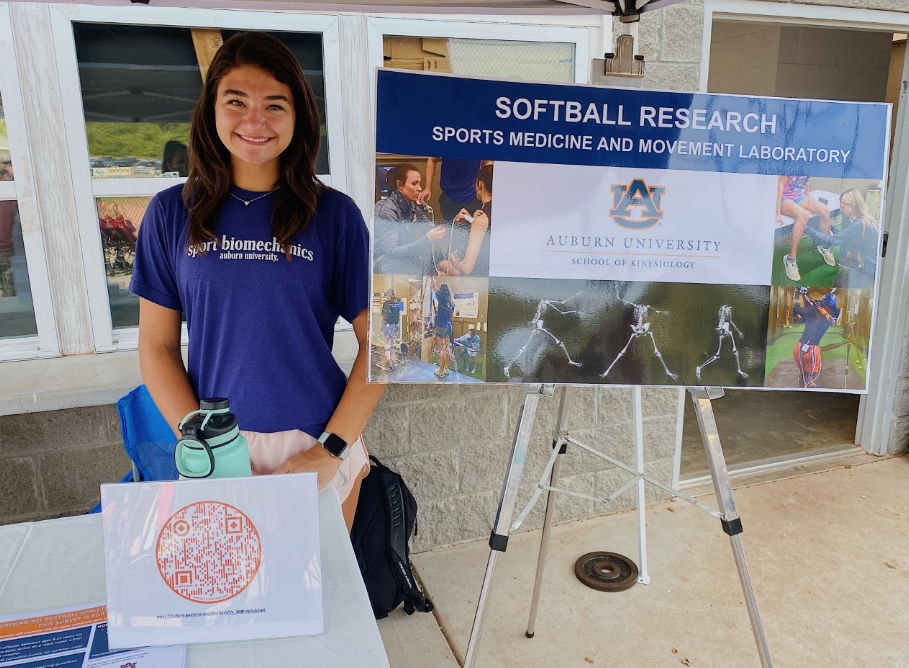
What are the differences in training volumes between softball pitchers with and without upper extremity pain? This is the question that Peyton Gober, a senior majoring in Exercise Science, aimed to answer during her undergraduate research fellowship. To conduct this study, Gober and her team recruited NCAA Division I collegiate softball pitchers and had them fill out questionnaires to obtain information on sport specialization factors. After thorough review of the questionnaires, the participants were placed into one of two groups: pain free or upper extremity pain. Results showed that there were no significant differences between the two groups when looking at their training volumes.
When asked what the most rewarding part of her undergraduate research experience was, Gober said that it was having the opportunity to take the lead on her own project after being involved in so many other student’s research studies. Also, having the opportunity to present her research at the Southeast American College of Sports Medicine conference was very rewarding.
Peyton Gober was a 2021-2022 Undergraduate Research Fellow in the School of Kinesiology, she was mentored by Dr. Gretchen Oliver.
Daisy Hansana

Can adding an arm swing, to a preparatory movement, improve jump performance? How does the added arm swing influence ankle movement during the jump? Daisy Hansana, a junior majoring in Exercise Science, aimed to answer this question during her undergraduate research fellowship. When conducting her studies, Hansana and her team had participants perform two conditions: jumps with an arm swing and jumps without an arm swing onto a force plate so that they could see their movements and the force values of the jump. Each participants conducted six total jumps, three of each jump, while connected to electrodes that allowed Hansana to monitor the movement of the participants through a motion camera. When comparing the results of the force values and the ankle angle, before and after the horizontal jump, there was an increase in all values. There was a correlation between adding an arm swing to the jump and an increased dorsiflexion (bend) of the ankle before the jump as well as an increased plantarflexion (extension) of the ankle after the jump. This correlation increased jump performance overall.
When asked how her undergraduate research experience has helped her in her specific field, Hansana spoke about her goals of continuing research in her future profession as a Physical Therapist. She notes that her experience in undergraduate research has prepared her to approach questions and conduct her own research that will improve the biomechanics of many lifestyles. According to Hansana, her experience has solidified her want to continue in research and has made her confident in the ability to do so.
Daisy Hansana was a 2020-2021 Undergraduate Research Fellow in the College of Education, she was mentored by Dr. Wendi Weimar.
Lucy Seay
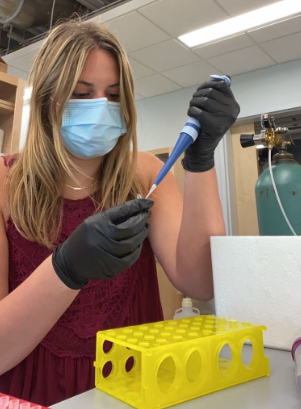
| How is the medicinal use of marijuana to reduce symptoms of morning sickness in pregnant women, going to effect the unborn fetus? With the legalization of marijuana in many states across the country, this is a growing concern that Lucy Seay aimed to answer during her undergraduate research fellowship. To conduct this research, Seay used hands-on approaches, writing codes, and analyzing biophysical data from rodent brain samples. Although the research is still being conducted, preliminary findings have shown that the effect of a prenatal exposure of marijuana on an unborn fetus can be harmful. When asked what the most rewarding part of her undergraduate research experience was, Seay said that it was having the opportunity to present at a virtual conference in front of knowledgeable scholars. “This opportunity provided me with confidence and real-world experience,” said Seay. Lucy Seay, a Sophomore in Computer Science Engineering and Pre-Medical, was a 2021-2022 Undergraduate Research Fellow. Her mentor was Dr. Subhrajit Bhattacharya. |
Corinne Gautreaux
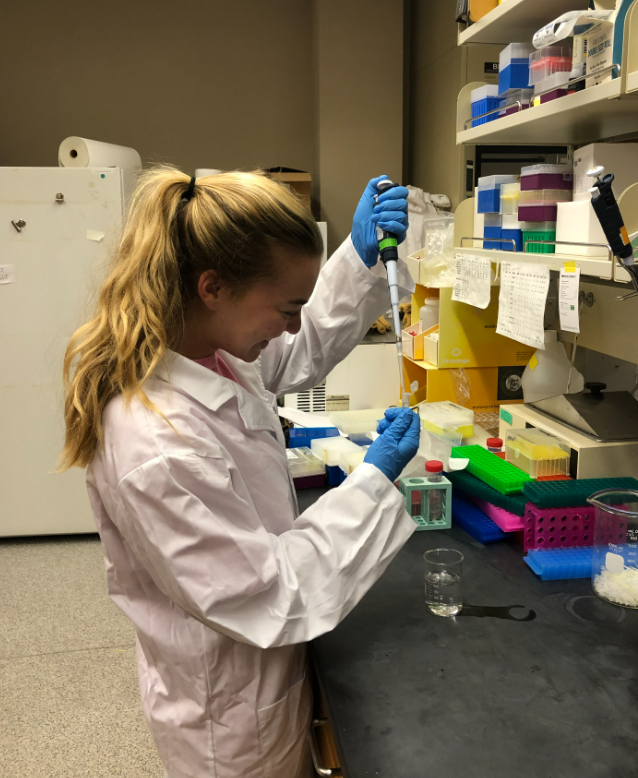
| Did diet quality and physical activity change in US adults because of the COVID-19 pandemic, and are those lifestyle changes associated with changes in BMI? This is what Corinne Gautreaux aimed to answer during her undergraduate research fellowship. Gautreaux stated that this research question is topically and medically relevant to understand how the pandemic may have affected nutritional and weight status in this population. To conduct this research, Gautreaux utilized a survey dataset, which was distributed online to adults across the United States to assess outcomes from June 2020, alongside additional questions that allowed participants to reflect on their behaviors prior to COVID-19. Results indicated that the changes in diet quality and physical activity are directly associated with weight changes. When asked what the most rewarding aspect of her undergraduate research fellowship experience was, Gautreaux said that it was her ability to take on her own research project, which increased her confidence in her research abilities. “My undergraduate research experience in human health has helped me understand that health is more than specifically medicine; rather, it is the combination of medicine with nutrition and lifestyle.” Corinne Gautreaux was a 2020-2021 Undergraduate Research Fellow in the College of Sciences and Mathematics. She was mentored by Dr. Andrew Fruge. |
Last Modified: